What is included in the endocrine system. Endocrine System: Glands, Hormones, and Their Vital Functions in the Human Body
What are the key components of the endocrine system. How do hormones regulate bodily functions. Which glands play crucial roles in hormone production. What are common endocrine disorders and their treatments.
The Endocrine System: A Network of Glands and Hormones
The endocrine system, also known as the hormonal system, is a complex network of glands and organs that produce and secrete hormones throughout the body. These chemical messengers play crucial roles in regulating various bodily functions, from metabolism and growth to reproduction and stress response.
Key Components of the Endocrine System
The endocrine system comprises several glands and organs, each responsible for producing specific hormones. The main components include:
- Hypothalamus
- Pituitary gland
- Pineal gland
- Thyroid gland
- Parathyroid glands
- Adrenal glands
- Pancreas
- Ovaries (in females)
- Testes (in males)
Each of these glands produces one or more hormones that influence various cellular functions throughout the body. Some hormones have widespread effects, while others target specific organs or tissues.
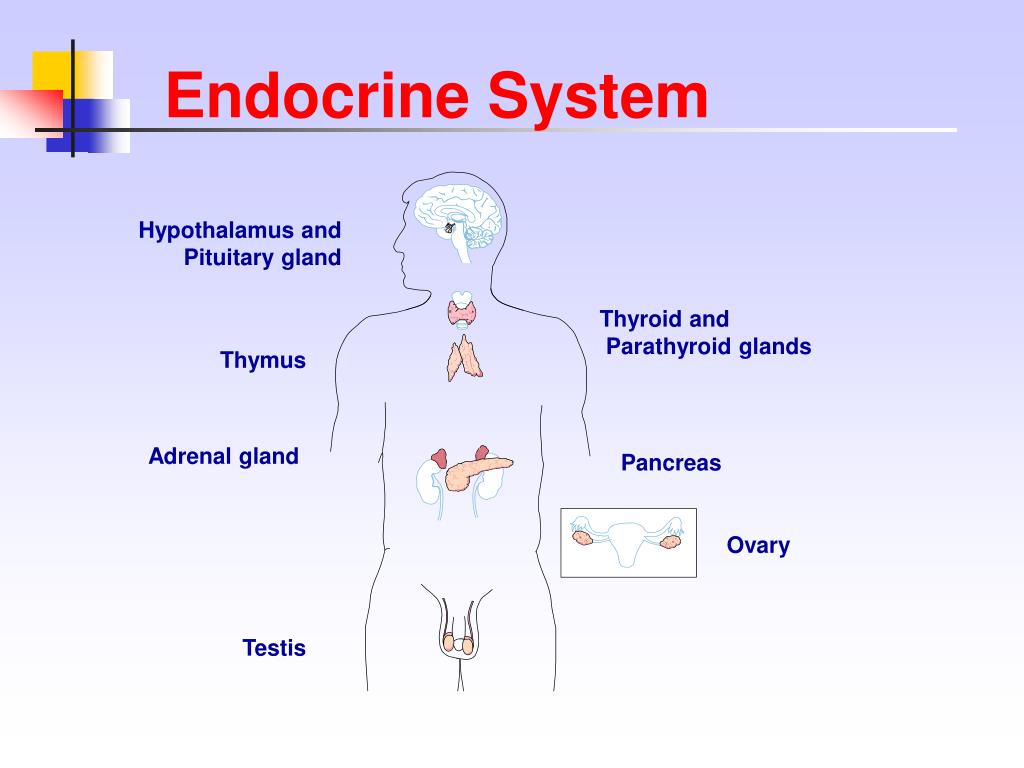
The Intricate Workings of the Hormonal System
The endocrine system operates through a complex process of hormone production, release, and reception. How does this process unfold?
- Hormone production: Glands synthesize hormones based on the body’s needs.
- Release into bloodstream: Hormones are secreted directly into the bloodstream.
- Circulation: Hormones travel throughout the body via the circulatory system.
- Target cell reception: Specific cells with matching receptors recognize and bind to the hormones.
- Cellular response: The target cells respond by altering their function or behavior as instructed by the hormone.
This system allows for precise control of various bodily functions, adapting to changing internal and external conditions.
Major Hormones and Their Functions
The endocrine system produces a wide array of hormones, each with specific roles in maintaining homeostasis and regulating bodily functions. Which hormones are considered essential, and what are their primary functions?

Growth Hormone (GH)
Produced by the pituitary gland, growth hormone is vital for:
- Normal physical growth in children
- Regulation of body composition in adults
- Maintenance of muscle and bone mass
- Influencing metabolism and fat distribution
Thyroxine (T4)
Secreted by the thyroid gland, thyroxine plays a crucial role in:
- Regulating metabolism
- Controlling body temperature
- Influencing heart rate and rhythm
- Supporting proper growth and development
Cortisol
Released by the adrenal glands, cortisol is essential for:
- Managing stress response
- Regulating blood pressure
- Controlling inflammation
- Influencing glucose metabolism
Insulin
Produced by the pancreas, insulin is crucial for:
- Regulating blood sugar levels
- Facilitating glucose uptake by cells
- Promoting energy storage
- Influencing protein synthesis
Sex Hormones
Estrogen and progesterone (in females) and testosterone (in males) are responsible for:
- Developing and maintaining secondary sexual characteristics
- Regulating reproductive functions
- Influencing bone density and muscle mass
- Affecting mood and cognitive function
The Hypothalamus-Pituitary Axis: The Master Regulators
The hypothalamus and pituitary gland form a crucial partnership in coordinating endocrine function. How do these structures work together to regulate hormone production throughout the body?

The hypothalamus, often referred to as the “master switchboard,” acts as a control center for the endocrine system. It continuously monitors the body’s internal environment and responds to various stimuli by producing releasing or inhibiting hormones. These hormones then travel to the pituitary gland, influencing its hormone production.
The pituitary gland, known as the “master gland,” responds to signals from the hypothalamus by secreting its own hormones. These pituitary hormones can either directly affect target tissues or stimulate other endocrine glands to produce specific hormones. This intricate feedback system allows for precise regulation of hormone levels in the body.
Endocrine Disorders: When the System Malfunctions
Despite its complexity and efficiency, the endocrine system can sometimes malfunction, leading to various disorders. What are some common endocrine disorders, and how do they affect the body?
Diabetes Mellitus
Diabetes is a group of metabolic disorders characterized by high blood sugar levels. It occurs when the body either doesn’t produce enough insulin (Type 1) or becomes resistant to insulin’s effects (Type 2). Symptoms may include excessive thirst, frequent urination, and unexplained weight loss.

Thyroid Disorders
Thyroid disorders can result in either overproduction (hyperthyroidism) or underproduction (hypothyroidism) of thyroid hormones. Symptoms vary depending on the condition but may include weight changes, fatigue, and mood disturbances.
Adrenal Insufficiency
This condition occurs when the adrenal glands don’t produce enough cortisol. It can lead to fatigue, weakness, and difficulty responding to stress.
Growth Hormone Deficiency
A lack of growth hormone can result in stunted growth in children and various metabolic issues in adults, including decreased muscle mass and increased body fat.
Diagnosis and Treatment of Endocrine Disorders
Endocrine disorders can be challenging to diagnose due to their often nonspecific symptoms. How are these conditions typically identified and treated?
Diagnostic Approaches
- Blood tests to measure hormone levels
- Imaging studies (e.g., ultrasound, CT, MRI) to examine gland structure
- Stimulation or suppression tests to assess gland function
- Genetic testing for inherited endocrine disorders
Treatment Options
Treatment for endocrine disorders typically aims to restore hormone balance. This may involve:

- Hormone replacement therapy
- Medications to suppress or stimulate hormone production
- Lifestyle modifications (e.g., diet, exercise)
- Surgery to remove or repair affected glands
An endocrinologist, a specialist in hormonal disorders, often manages the diagnosis and treatment of these conditions.
The Endocrine System and Overall Health
The endocrine system’s influence extends far beyond individual glands and hormones. How does this complex network impact overall health and well-being?
Metabolism and Energy Balance
Hormones play a crucial role in regulating metabolism, influencing how the body uses and stores energy. This affects everything from weight management to energy levels throughout the day.
Growth and Development
From fetal development through adolescence and into adulthood, hormones guide the body’s growth and maturation processes.
Stress Response
The endocrine system, particularly the adrenal glands, helps the body respond to and cope with various stressors, both physical and emotional.
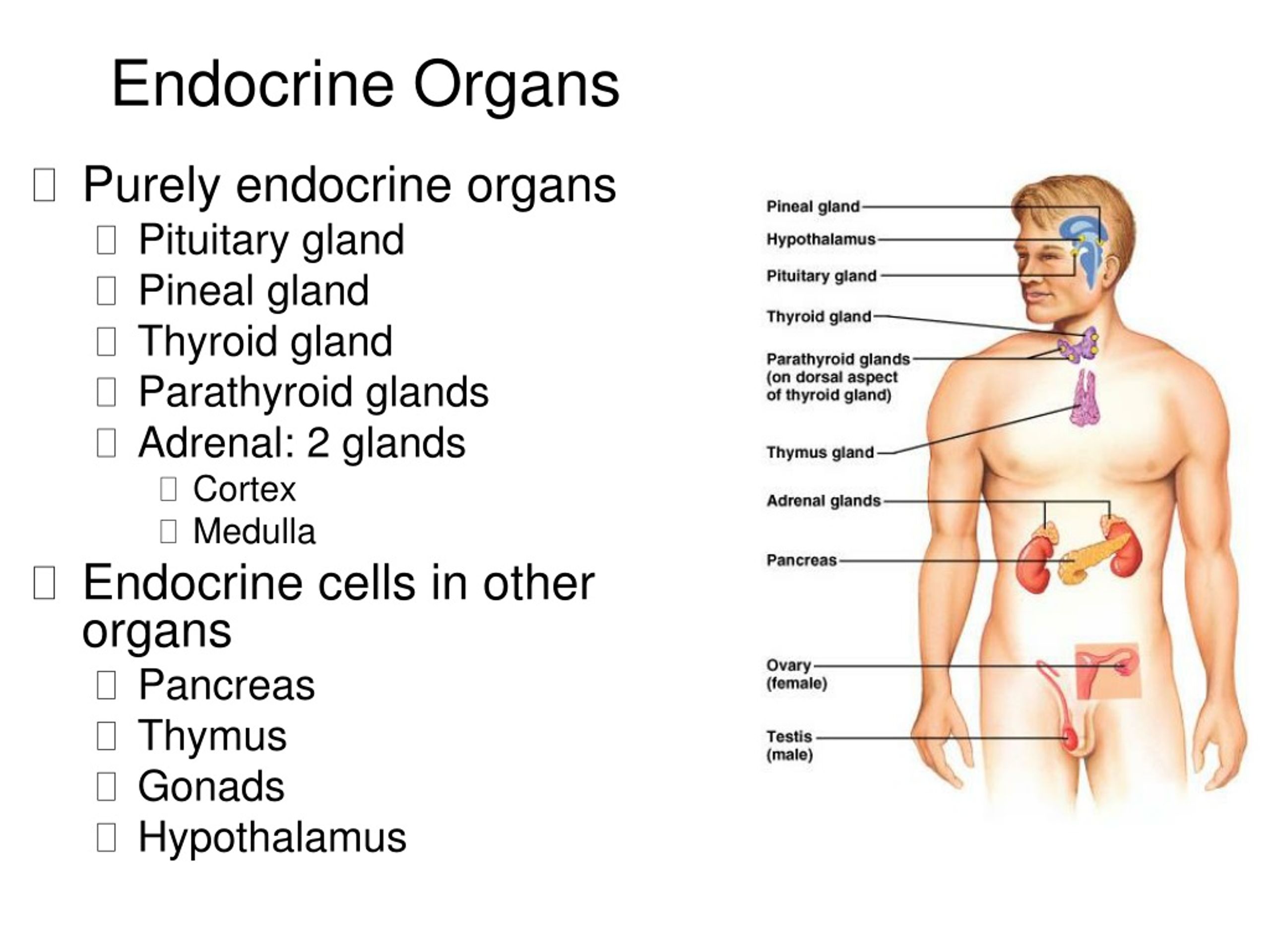
Reproduction
Hormones regulate all aspects of reproduction, from sexual development and function to pregnancy and childbirth.
Mood and Cognitive Function
Many hormones influence brain function, affecting mood, memory, and cognitive performance.
Understanding the far-reaching effects of the endocrine system highlights the importance of maintaining hormonal balance for overall health and well-being.
Emerging Research and Future Directions in Endocrinology
The field of endocrinology continues to evolve, with new discoveries and treatment approaches emerging. What are some exciting areas of research in endocrine science?
Personalized Medicine
Researchers are exploring ways to tailor hormone treatments to individual genetic profiles, potentially improving efficacy and reducing side effects.
Endocrine Disruptors
There’s growing interest in understanding how environmental chemicals may interfere with hormone function and contribute to various health issues.
Gut-Endocrine Connections
The relationship between gut microbiota and endocrine function is an active area of study, potentially offering new insights into metabolic disorders.
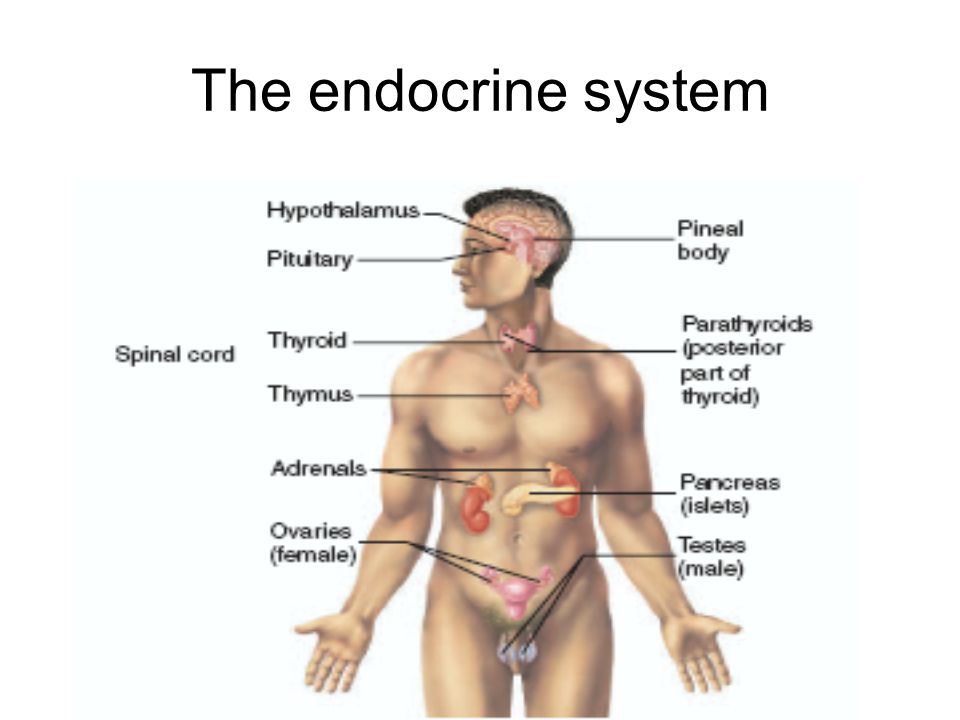
Advanced Hormone Delivery Systems
Development of novel methods for hormone delivery, such as long-acting implants or smart pumps, may improve treatment outcomes for various endocrine disorders.
Artificial Intelligence in Endocrinology
AI and machine learning technologies are being explored for their potential to improve diagnosis, treatment planning, and monitoring of endocrine conditions.
These research directions hold promise for enhancing our understanding of the endocrine system and developing more effective treatments for hormonal disorders.
Hormonal system – what it is and how it works
On this page
What is the hormonal system?
The hormonal system, also called the endocrine system, is a network of glands and organs in the body that produces hormones.
Several glands make hormones, including the hypothalamus, the pituitary gland, the pineal gland, the thyroid gland, the parathyroid glands, the adrenal glands, the pancreas, ovaries and testes.
Each gland makes one or more hormones. Hormones are important for almost all cells in the body to work. They influence the metabolism, growth and many other functions. Some hormones influence almost all cells in the body. Others only influence a small number of cells in specific organs.
Some glands ‘talk to’ other glands, telling them to release particular hormones. For example, the pituitary gland releases hormones that tell the thyroid gland, the adrenal glands, the ovaries and the testes to release hormones.
How does the hormonal system work?
When a hormone is released from a gland, it travels in the bloodstream through the body. It passes by most cells, but eventually reaches its target.
It passes by most cells, but eventually reaches its target.
When it reaches its target, it attaches to a particular type of cell, known as a receptor cell. The hormone then tells the receptor cell to do something. It can make cells grow faster, release another hormone, absorb sugar from the blood, withhold water from the kidneys, or one of many other important functions in the body.
What are some examples of hormones?
Some examples of hormones are:
Growth hormone: This is released from the pituitary gland. It is essential for normal physical growth in children and for some functions in adults, such as fat and muscle mass.
Thyroxine: The thyroid gland (in the neck) converts iodine from the diet into thyroxine. This controls many functions of the metabolism, including temperature, heart rate and growth.
Cortisol: This is released from the adrenal glands (just above the kidneys). It is important for controlling blood pressure and for dealing with the body’s response to stress.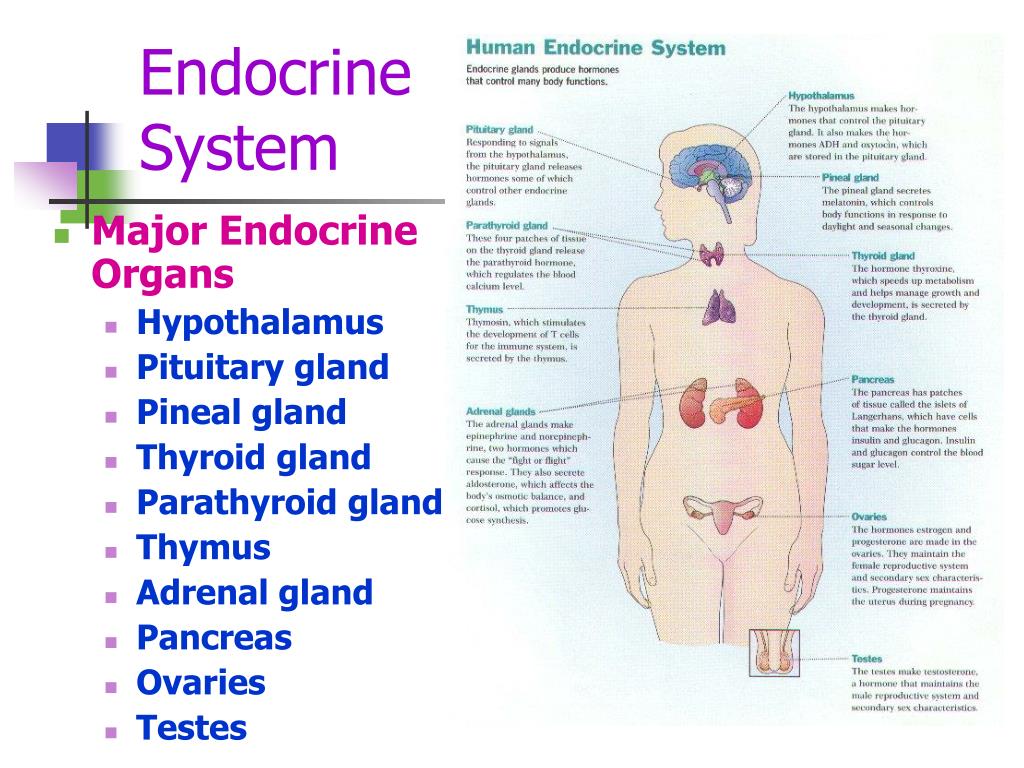
Insulin: This is produced by islet cells in the pancreas. It controls blood sugar levels.
Oestrogen and progesterone: These hormones, released from the ovaries, are responsible for female body characteristics and for storing and releasing eggs.
Testosterone: This is released from the testes. It produces male body characteristics and sperm.
Find out more about the main endocrine glands and their hormones.
What medical conditions relate to the hormonal system?
The hormonal system can go wrong. Glands might produce too many or too few hormones, or the target cells might stop responding properly to the hormones.
Some common hormonal problems are:
These problems are usually treated by controlling how much hormone the body makes. An endocrinologist (endocrine gland specialist) can help diagnose and treat the problem.
Endocrine glands | Multimedia Encyclopedia | Health Information
Endocrine glands
The endocrine system is primarily composed of glands that produce chemical messengers called hormones.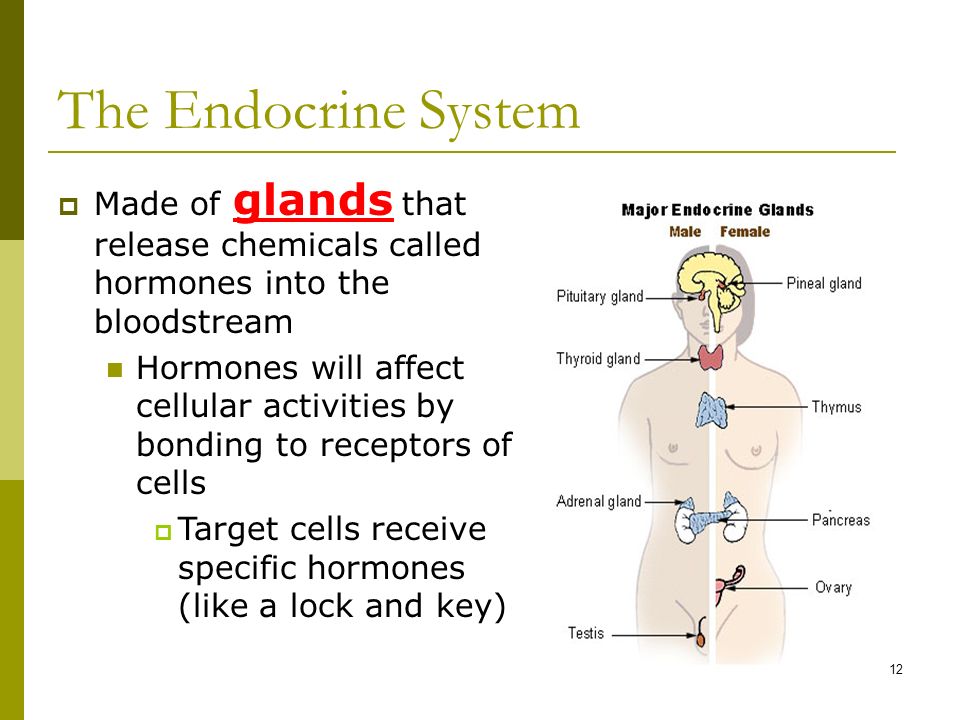 Glands of the endocrine system include the pituitary gland, the thyroid gland, the parathyroid glands, the thymus, and the adrenal glands.
Glands of the endocrine system include the pituitary gland, the thyroid gland, the parathyroid glands, the thymus, and the adrenal glands.
Other glands are also included within the endocrine system since they contain endocrine tissue that secretes hormones. These include the pancreas, ovaries and testes.
The endocrine and nervous systems work very closely together. The brain continuously sends instructions to the endocrine system, and in return receives feedback from the endocrine glands. Because of this intimate relationship, the nervous and endocrine systems are referred to as the neuroendocrine system.
The hypothalamus is known as the master switchboard because it’s the part of the brain that controls the endocrine system. The pituitary gland, which hangs by a thin stalk from the hypothalamus, is called the master gland of the body because it regulates the activity of the endocrine glands.
The hypothalamus detects the rising level of the target organ’s hormones then sends either hormonal or electrical messages to the pituitary gland. In response, the pituitary gland releases hormones, which travel through the bloodstream to a target endocrine gland, instructing it to stop producing its hormones.
Here’s how the endocrine system keeps itself in check: eventually, the hypothalamus detects the rising level of the target organ’s hormones, and sends a message to the pituitary gland. The pituitary gland then stops releasing certain hormones, causing the target organ to stop producing its hormones.
The endocrine system constantly adjusts hormone levels so that the body can function normally. This process is called homeostasis.
An Overview of the Endocrine System – Anatomy and Physiology
Learning Objectives
By the end of this section, you will be able to:
- Distinguish the types of intercellular communication, their importance, mechanisms, and effects
- Identify the major organs and tissues of the endocrine system and their location in the body
Communication is a process in which a sender transmits signals to one or more receivers to control and coordinate actions. In the human body, two major organ systems participate in relatively “long distance” communication: the nervous system and the endocrine system. Together, these two systems are primarily responsible for maintaining homeostasis in the body.
In the human body, two major organ systems participate in relatively “long distance” communication: the nervous system and the endocrine system. Together, these two systems are primarily responsible for maintaining homeostasis in the body.
Neural and Endocrine Signaling
The nervous system uses two types of intercellular communication—electrical and chemical signaling—either by the direct action of an electrical potential, or in the latter case, through the action of chemical neurotransmitters such as serotonin or norepinephrine. Neurotransmitters act locally and rapidly. When an electrical signal in the form of an action potential arrives at the synaptic terminal, they diffuse across the synaptic cleft (the gap between a sending neuron and a receiving neuron or muscle cell). Once the neurotransmitters interact (bind) with receptors on the receiving (post-synaptic) cell, the receptor stimulation is transduced into a response such as continued electrical signaling or modification of cellular response.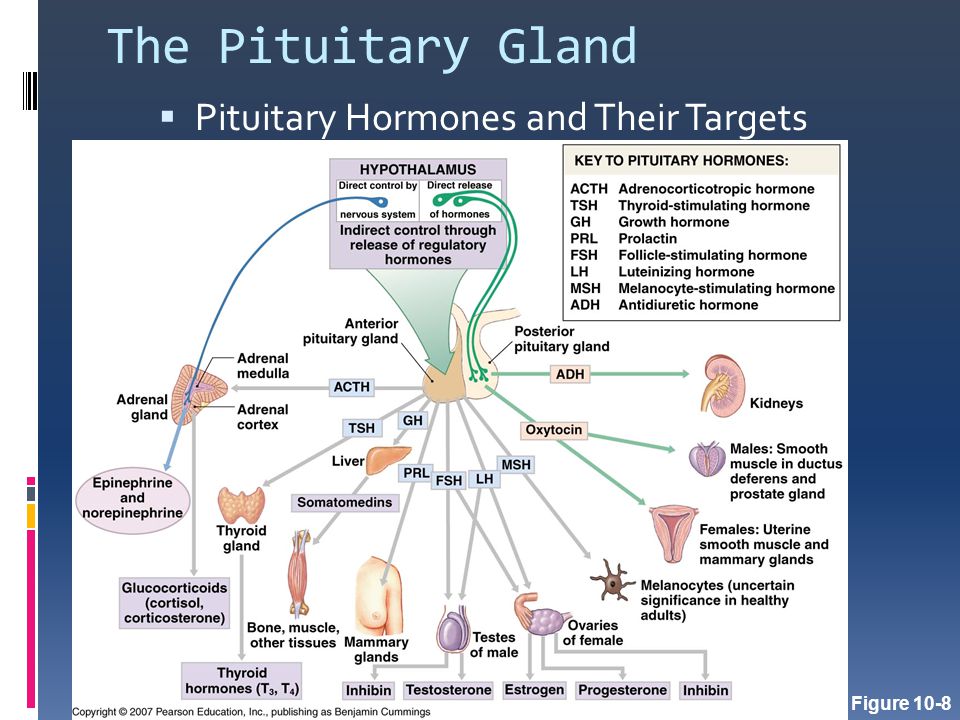 The target cell responds within milliseconds of receiving the chemical “message”; this response then ceases very quickly once the neural signaling ends. In this way, neural communication enables body functions that involve quick, brief actions, such as movement, sensation, and cognition.In contrast, the endocrine system uses just one method of communication: chemical signaling. These signals are sent by the endocrine organs, which secrete chemicals—the hormone—into the extracellular fluid. Hormones are transported primarily via the bloodstream throughout the body, where they bind to receptors on target cells, inducing a characteristic response. As a result, endocrine signaling requires more time than neural signaling to prompt a response in target cells, though the precise amount of time varies with different hormones. For example, the hormones released when you are confronted with a dangerous or frightening situation, called the fight-or-flight response, occur by the release of adrenal hormones—epinephrine and norepinephrine—within seconds.
The target cell responds within milliseconds of receiving the chemical “message”; this response then ceases very quickly once the neural signaling ends. In this way, neural communication enables body functions that involve quick, brief actions, such as movement, sensation, and cognition.In contrast, the endocrine system uses just one method of communication: chemical signaling. These signals are sent by the endocrine organs, which secrete chemicals—the hormone—into the extracellular fluid. Hormones are transported primarily via the bloodstream throughout the body, where they bind to receptors on target cells, inducing a characteristic response. As a result, endocrine signaling requires more time than neural signaling to prompt a response in target cells, though the precise amount of time varies with different hormones. For example, the hormones released when you are confronted with a dangerous or frightening situation, called the fight-or-flight response, occur by the release of adrenal hormones—epinephrine and norepinephrine—within seconds.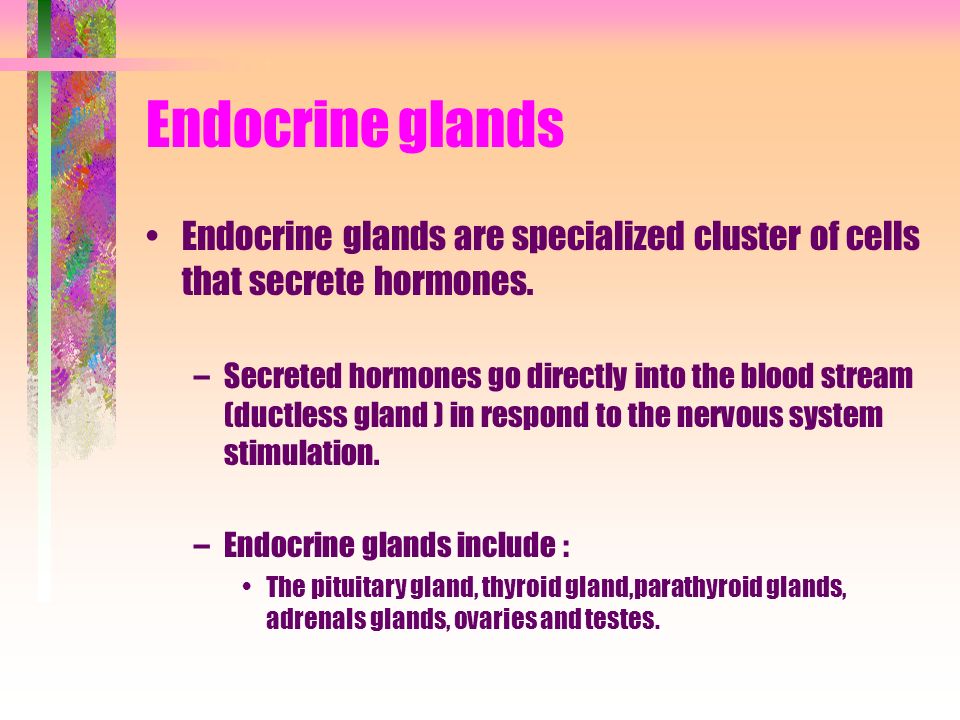 In contrast, it may take up to 48 hours for target cells to respond to certain reproductive hormones.
In contrast, it may take up to 48 hours for target cells to respond to certain reproductive hormones.
Visit this link to watch an animation of the events that occur when a hormone binds to a cell membrane receptor. What is the secondary messenger made by adenylyl cyclase during the activation of liver cells by epinephrine?
In addition, endocrine signaling is typically less specific than neural signaling. The same hormone may play a role in a variety of different physiological processes depending on the target cells involved. For example, the hormone oxytocin promotes uterine contractions in women in labor. It is also important in breastfeeding, and may be involved in the sexual response and in feelings of emotional attachment in both males and females.
In general, the nervous system involves quick responses to rapid changes in the external environment, and the endocrine system is usually slower acting—taking care of the internal environment of the body, maintaining homeostasis, and controlling reproduction ((Figure)).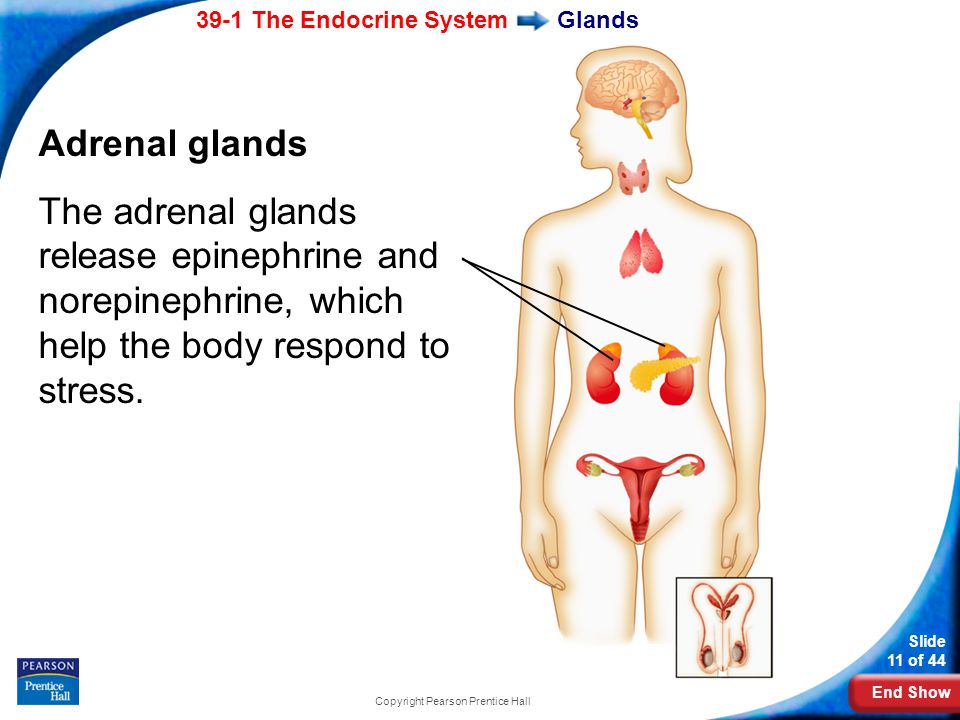 So how does the fight-or-flight response that was mentioned earlier happen so quickly if hormones are usually slower acting? It is because the two systems are connected. It is the fast action of the nervous system in response to the danger in the environment that stimulates the adrenal glands to secrete their hormones. As a result, the nervous system can cause rapid endocrine responses to keep up with sudden changes in both the external and internal environments when necessary.
So how does the fight-or-flight response that was mentioned earlier happen so quickly if hormones are usually slower acting? It is because the two systems are connected. It is the fast action of the nervous system in response to the danger in the environment that stimulates the adrenal glands to secrete their hormones. As a result, the nervous system can cause rapid endocrine responses to keep up with sudden changes in both the external and internal environments when necessary.
| Endocrine and Nervous Systems | ||
|---|---|---|
| Endocrine system | Nervous system | |
| Signaling mechanism(s) | Chemical | Chemical/electrical |
| Primary chemical signal | Hormones | Neurotransmitters |
| Distance traveled | Long or short | Always short |
| Response time | Fast or slow | Always fast |
| Environment targeted | Internal | Internal and external |
Structures of the Endocrine System
The endocrine system consists of cells, tissues, and organs that secrete hormones as a primary or secondary function.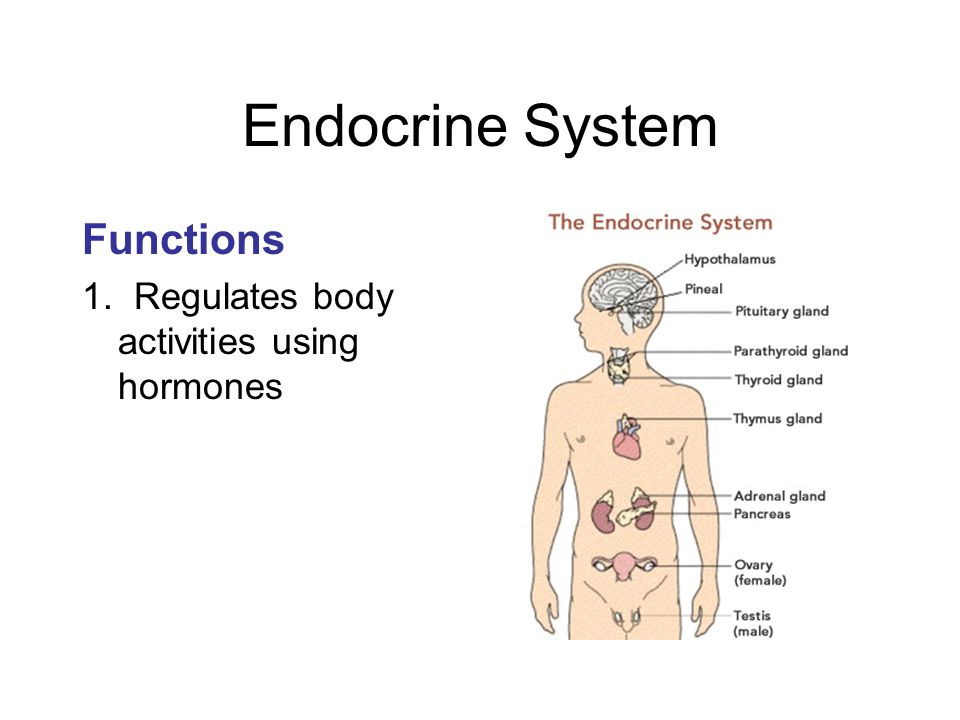 The endocrine gland is the major player in this system. The primary function of these ductless glands is to secrete their hormones directly into the surrounding fluid. The interstitial fluid and the blood vessels then transport the hormones throughout the body. The endocrine system includes the pituitary, thyroid, parathyroid, adrenal, and pineal glands ((Figure)). Some of these glands have both endocrine and non-endocrine functions. For example, the pancreas contains cells that function in digestion as well as cells that secrete the hormones insulin and glucagon, which regulate blood glucose levels. The hypothalamus, thymus, heart, kidneys, stomach, small intestine, liver, skin, female ovaries, and male testes are other organs that contain cells with endocrine function. Moreover, adipose tissue has long been known to produce hormones, and recent research has revealed that even bone tissue has endocrine functions.
The endocrine gland is the major player in this system. The primary function of these ductless glands is to secrete their hormones directly into the surrounding fluid. The interstitial fluid and the blood vessels then transport the hormones throughout the body. The endocrine system includes the pituitary, thyroid, parathyroid, adrenal, and pineal glands ((Figure)). Some of these glands have both endocrine and non-endocrine functions. For example, the pancreas contains cells that function in digestion as well as cells that secrete the hormones insulin and glucagon, which regulate blood glucose levels. The hypothalamus, thymus, heart, kidneys, stomach, small intestine, liver, skin, female ovaries, and male testes are other organs that contain cells with endocrine function. Moreover, adipose tissue has long been known to produce hormones, and recent research has revealed that even bone tissue has endocrine functions.
Endocrine System
Endocrine glands and cells are located throughout the body and play an important role in homeostasis.
The ductless endocrine glands are not to be confused with the body’s exocrine system, whose glands release their secretions through ducts. Examples of exocrine glands include the sebaceous and sweat glands of the skin. As just noted, the pancreas also has an exocrine function: most of its cells secrete pancreatic juice through the pancreatic and accessory ducts to the lumen of the small intestine.
Other Types of Chemical Signaling
In endocrine signaling, hormones secreted into the extracellular fluid diffuse into the blood or lymph, and can then travel great distances throughout the body. In contrast, autocrine signaling takes place within the same cell. An autocrine (auto- = “self”) is a chemical that elicits a response in the same cell that secreted it. Interleukin-1, or IL-1, is a signaling molecule that plays an important role in inflammatory response. The cells that secrete IL-1 have receptors on their cell surface that bind these molecules, resulting in autocrine signaling.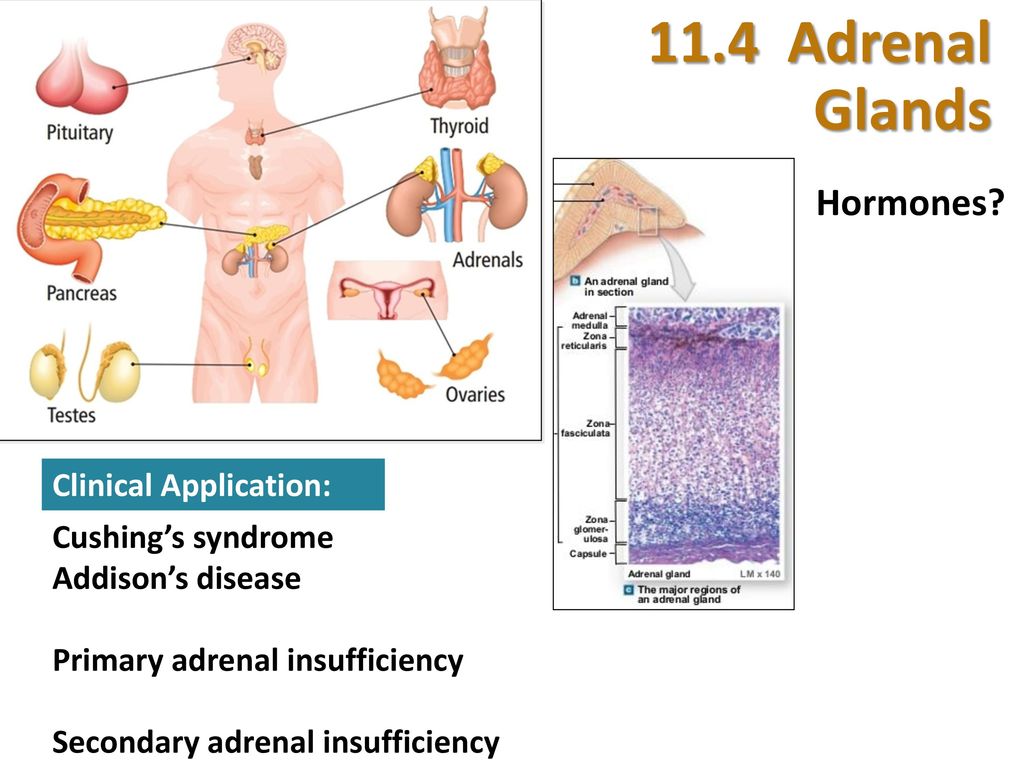
Local intercellular communication is the province of the paracrine, also called a paracrine factor, which is a chemical that induces a response in neighboring cells. Although paracrines may enter the bloodstream, their concentration is generally too low to elicit a response from distant tissues. A familiar example to those with asthma is histamine, a paracrine that is released by immune cells in the bronchial tree. Histamine causes the smooth muscle cells of the bronchi to constrict, narrowing the airways. Another example is the neurotransmitters of the nervous system, which act only locally within the synaptic cleft.
Career Connections
Endocrinologist Endocrinology is a specialty in the field of medicine that focuses on the treatment of endocrine system disorders. Endocrinologists—medical doctors who specialize in this field—are experts in treating diseases associated with hormonal systems, ranging from thyroid disease to diabetes mellitus. Endocrine surgeons treat endocrine disease through the removal, or resection, of the affected endocrine gland.
Patients who are referred to endocrinologists may have signs and symptoms or blood test results that suggest excessive or impaired functioning of an endocrine gland or endocrine cells. The endocrinologist may order additional blood tests to determine whether the patient’s hormonal levels are abnormal, or they may stimulate or suppress the function of the suspect endocrine gland and then have blood taken for analysis. Treatment varies according to the diagnosis. Some endocrine disorders, such as type 2 diabetes, may respond to lifestyle changes such as modest weight loss, adoption of a healthy diet, and regular physical activity. Other disorders may require medication, such as hormone replacement, and routine monitoring by the endocrinologist. These include disorders of the pituitary gland that can affect growth and disorders of the thyroid gland that can result in a variety of metabolic problems.
Some patients experience health problems as a result of the normal decline in hormones that can accompany aging. These patients can consult with an endocrinologist to weigh the risks and benefits of hormone replacement therapy intended to boost their natural levels of reproductive hormones.
These patients can consult with an endocrinologist to weigh the risks and benefits of hormone replacement therapy intended to boost their natural levels of reproductive hormones.
In addition to treating patients, endocrinologists may be involved in research to improve the understanding of endocrine system disorders and develop new treatments for these diseases.
Chapter Review
The endocrine system consists of cells, tissues, and organs that secrete hormones critical to homeostasis. The body coordinates its functions through two major types of communication: neural and endocrine. Neural communication includes both electrical and chemical signaling between neurons and target cells. Endocrine communication involves chemical signaling via the release of hormones into the extracellular fluid. From there, hormones diffuse into the bloodstream and may travel to distant body regions, where they elicit a response in target cells. Endocrine glands are ductless glands that secrete hormones. Many organs of the body with other primary functions—such as the heart, stomach, and kidneys—also have hormone-secreting cells.
Many organs of the body with other primary functions—such as the heart, stomach, and kidneys—also have hormone-secreting cells.
Interactive Link Questions
Visit this link to watch an animation of the events that occur when a hormone binds to a cell membrane receptor. What is the secondary messenger made by adenylyl cyclase during the activation of liver cells by epinephrine?
Review Questions
Endocrine glands ________.
- secrete hormones that travel through a duct to the target organs
- release neurotransmitters into the synaptic cleft
- secrete chemical messengers that travel in the bloodstream
- include sebaceous glands and sweat glands
Chemical signaling that affects neighboring cells is called ________.
- autocrine
- paracrine
- endocrine
- neuron
Critical Thinking Questions
Describe several main differences in the communication methods used by the endocrine system and the nervous system.
The endocrine system uses chemical signals called hormones to convey information from one part of the body to a distant part of the body. Hormones are released from the endocrine cell into the extracellular environment, but then travel in the bloodstream to target tissues. This communication and response can take seconds to days. In contrast, neurons transmit electrical signals along their axons. At the axon terminal, the electrical signal prompts the release of a chemical signal called a neurotransmitter that carries the message across the synaptic cleft to elicit a response in the neighboring cell. This method of communication is nearly instantaneous, of very brief duration, and is highly specific.
Compare and contrast endocrine and exocrine glands.
Endocrine glands are ductless. They release their secretion into the surrounding fluid, from which it enters the bloodstream or lymph to travel to distant cells. Moreover, the secretions of endocrine glands are hormones. Exocrine glands release their secretions through a duct that delivers the secretion to the target location. Moreover, the secretions of exocrine glands are not hormones, but compounds that have an immediate physiologic function. For example, pancreatic juice contains enzymes that help digest food.
Exocrine glands release their secretions through a duct that delivers the secretion to the target location. Moreover, the secretions of exocrine glands are not hormones, but compounds that have an immediate physiologic function. For example, pancreatic juice contains enzymes that help digest food.
True or false: Neurotransmitters are a special class of paracrines. Explain your answer.
True. Neurotransmitters can be classified as paracrines because, upon their release from a neuron’s axon terminals, they travel across a microscopically small cleft to exert their effect on a nearby neuron or muscle cell.
Glossary
- autocrine
- chemical signal that elicits a response in the same cell that secreted it
- endocrine gland
- tissue or organ that secretes hormones into the blood and lymph without ducts such that they may be transported to organs distant from the site of secretion
- endocrine system
- cells, tissues, and organs that secrete hormones as a primary or secondary function and play an integral role in normal bodily processes
- exocrine system
- cells, tissues, and organs that secrete substances directly to target tissues via glandular ducts
- hormone
- secretion of an endocrine organ that travels via the bloodstream or lymphatics to induce a response in target cells or tissues in another part of the body
- paracrine
- chemical signal that elicits a response in neighboring cells; also called paracrine factor
What Is Endocrinology? | American Association of Clinical Endocrinology
The Basics
Endocrinology is a branch of medicine that deals with the endocrine system, which controls the hormones in your body. An endocrinologist is a physician who specializes in the field of endocrinology. Endocrinologists diagnose and treat a wide range of conditions affecting the endocrine system, including diabetes mellitus, thyroid disorders, osteoporosis, growth hormone deficiency, infertility, cholesterol problems, hypertension (high blood pressure), obesity and more.
An endocrinologist is a physician who specializes in the field of endocrinology. Endocrinologists diagnose and treat a wide range of conditions affecting the endocrine system, including diabetes mellitus, thyroid disorders, osteoporosis, growth hormone deficiency, infertility, cholesterol problems, hypertension (high blood pressure), obesity and more.
How the Endocrine System Works
The endocrine system’s glands and organs release hormones that regulate a number of vital functions of our body. These glands include the hypothalamus, pineal body, pituitary, thyroid, parathyroids, adrenals, pancreas, testes and ovaries.
The hormones in your body all have specific jobs to complete. There are up to 40 different hormones circulating in your blood at any time. Once released into the bloodstream, a hormone travels throughout the body until it reaches its specific destination(s) to perform its function. These destinations, called targets, can be located either on other endocrine glands or on other organs and tissues in the body.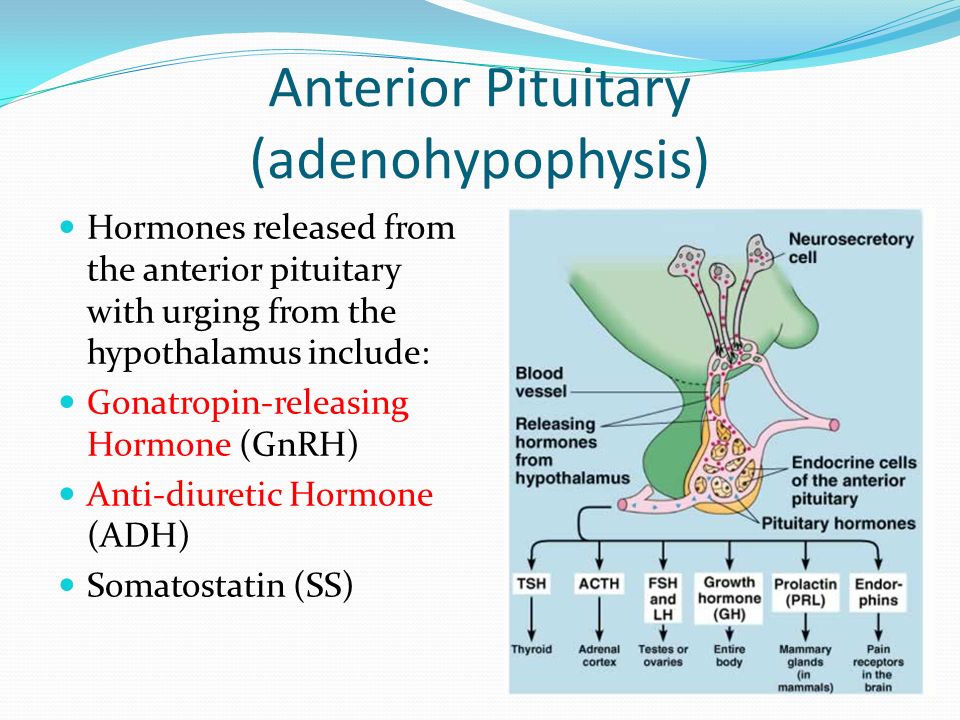
When a hormone reaches its target, it tells that part of your body what work to do, when to do it and for how long. Hormones are often referred to as the “messengers” because they help different parts of the body communicate. Overall, they are involved in many different processes in the body, including:
- Blood sugar control
- Growth and development
- Metabolism (the process of getting and maintaining energy in the body)
- Regulation of heart rate and blood pressure
- Sexual development and function
- Reproduction
- Mood
What Happens When the Endocrine System Does Not Work?
Hormonal function is a balancing act. Too much or too little of one hormone can have an impact on the release of other hormones. If this hormonal imbalance occurs, some of your body’s systems will not work properly.
These imbalances can often be corrected by the body itself. Your body has built-in mechanisms to keep track of and respond to any changes in hormone levels to bring them back to normal and restore the balance.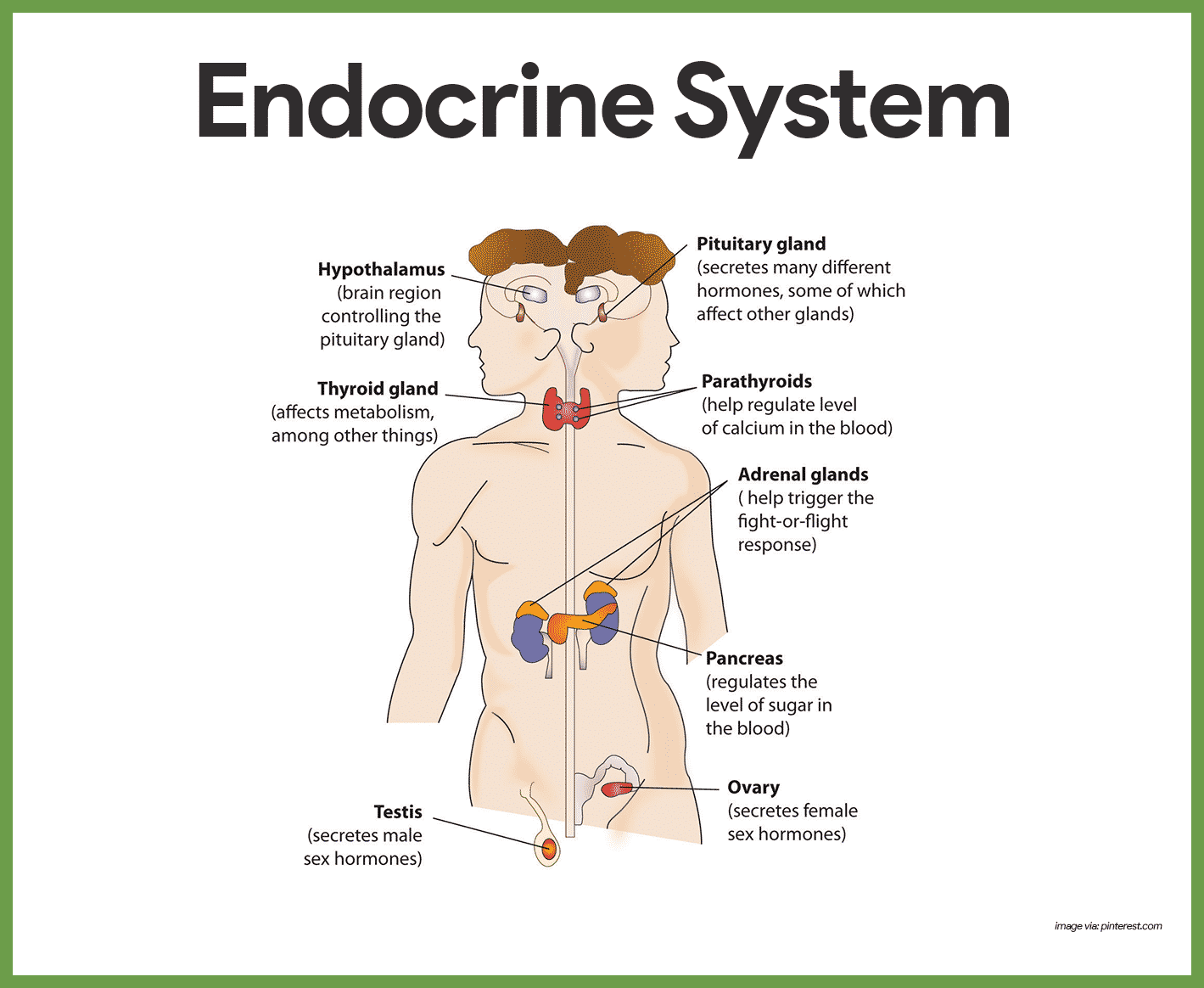
Sometimes, however, this system goes wrong and there can be a problem that the body can’t fix itself. In this case, a primary care physician will refer you to an endocrinologist, who is an expert in treating frequently complex (and often chronic) conditions which can involve several different systems within the body.
The Anatomy of the Endocrine System
The endocrine system is made up of a collection of glands. Each gland has a specific function in the body, and all these glands work together to regulate vital functions of our body.
Adrenal glands
Located just above the kidneys, adrenal glands are responsible for the secretion of several hormones which maintain the body’s salt and water balance that in turn regulate blood pressure, help the body cope with and respond to stress, regulate body metabolism, and play a role in early development of the male sex organs in childhood and female body hair during puberty.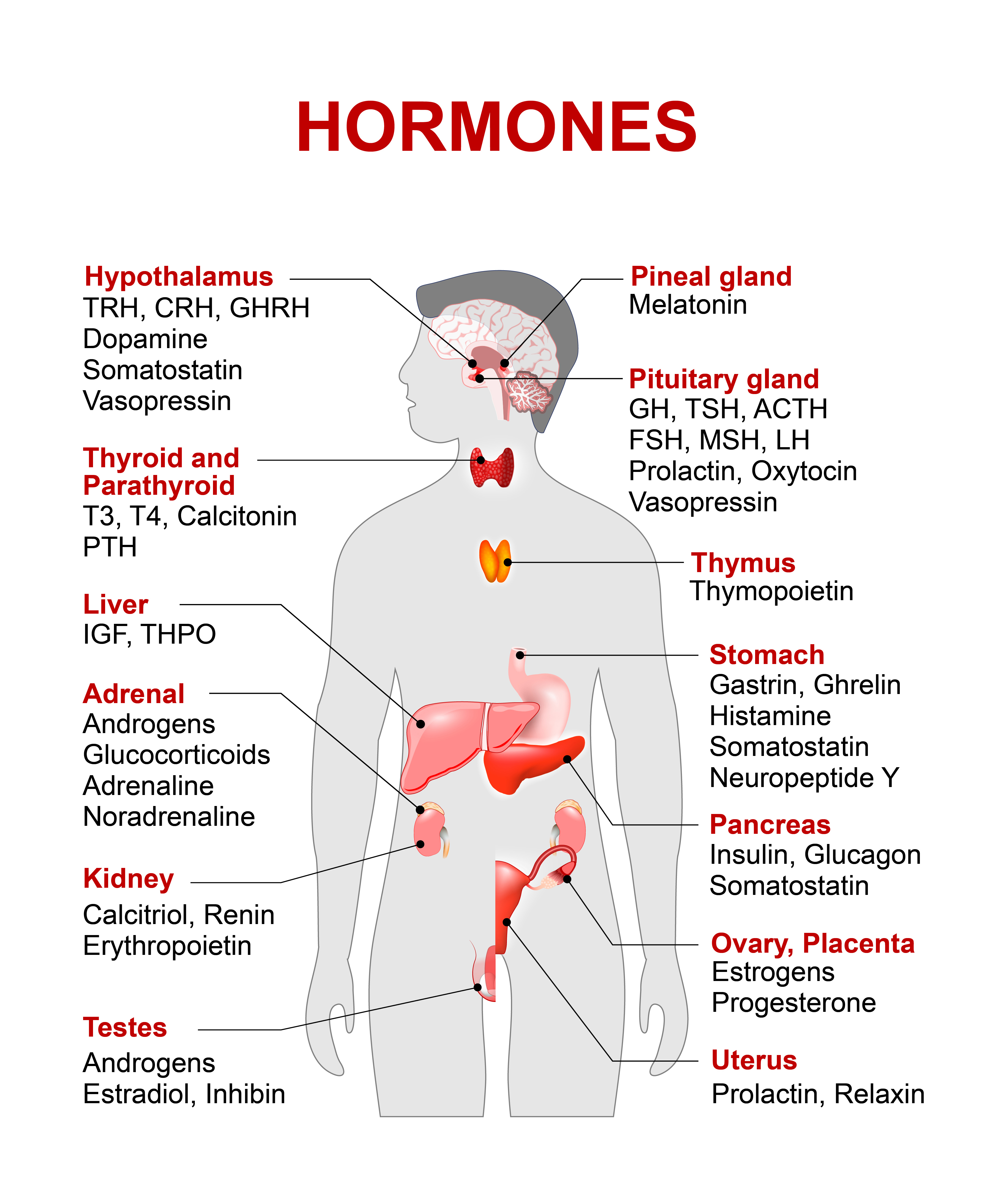 The adrenal glands secrete 3 major hormones: mineralocorticoids (predominantly aldosterone), glucocorticoids (predominantly cortisol), and androgens (predominantly testosterone and dehydroepiandrosterone).
The adrenal glands secrete 3 major hormones: mineralocorticoids (predominantly aldosterone), glucocorticoids (predominantly cortisol), and androgens (predominantly testosterone and dehydroepiandrosterone).
Hypothalamus
The hypothalamus is located just above the brain stem. It serves as the link between the endocrine system and the nervous system by communicating with the pituitary gland. It controls the pituitary gland by increasing or decreasing the release of hormones. It activates and controls involuntary functions such as body temperature, hunger and thirst.
Pituitary gland
No larger than the size of a pea, the pituitary is often referred to as the “master” gland because it releases hormones that regulate the function of endocrine glands such as the thyroid, adrenals and reproductive glands. It also produces hormones that stimulate the growth of bones and tissues, affect sexual development, encourage reabsorption of water by the kidneys and even trigger uterine contractions during and after labor.
Pineal body (pineal gland)
Located deep in the center of the brain, the pineal gland regulates several body functions through secretion of the hormone melatonin. Melatonin is released in a rhythmic cycle; it’s higher at night and helps regulate the sleep/wake cycle.
Pancreas
Located in the abdomen, the pancreas is both a digestive organ and an endocrine gland. The “islets of Langerhans” are the regions of the pancreas that contain its hormone-producing cells. The two primary endocrine functions of these cells are to keep the body supplied with fuel for energy and to help in food digestion by releasing digestive enzymes. The pancreas is the gland involved in diabetes.
Parathyroid glands
Each the size of a grain of rice, the body’s four parathyroid glands monitor the calcium level in our bodies. Parathyroid glands control the calcium levels in our blood, in our bones and throughout our body. Parathyroid glands regulate the calcium by producing a hormone called parathyroid hormone (PTH). The parathyroid glands also help the lining of the intestines become more efficient at absorbing calcium in the diet.
Parathyroid glands regulate the calcium by producing a hormone called parathyroid hormone (PTH). The parathyroid glands also help the lining of the intestines become more efficient at absorbing calcium in the diet.
Thyroid gland
The butterfly-shaped thyroid takes iodine and converts it into two hormones (T3 and T4). These hormones move through the body and enter cells to regulate metabolism, including blood pressure, body temperature, heart rate and how the body reacts to other hormones.
The thyroid gland also produces calcitonin, which opposes the effects of PTH and acts to lower blood calcium levels. Calcitonin lowers blood calcium level by increasing the amount of calcium excreted in the urine and suppressing the activity of the osteoclasts, cells that degrade bone. Learn more about the thyroid and related conditions, such as hyperthyroidism.
Ovaries
The ovaries are the female sex glands. They have two main reproductive functions in the body: they produce oocytes (eggs) for fertilization and the reproductive hormones estrogen and progesterone.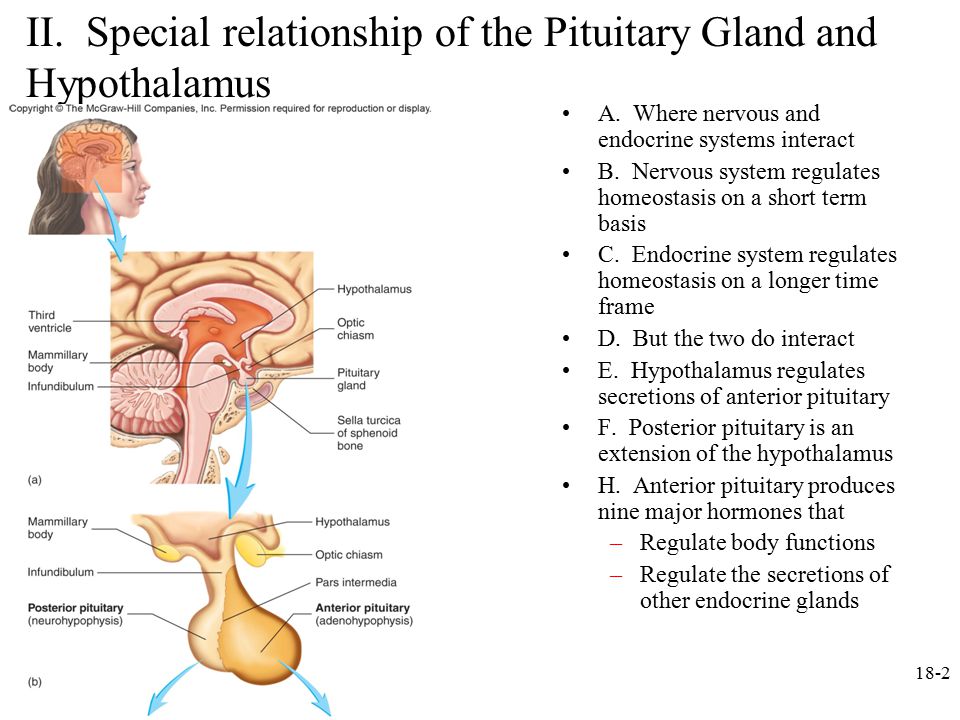
Estrogen is involved in the development of female sexual features such as breast growth, the accumulation of body fat around the hips and thighs and the growth spurt that occurs during puberty. Both estrogen and progesterone are also involved in the regulation of the menstrual cycle and prepare the lining of the uterus for pregnancy.
Testes
The testes are the testicles or male sex glands. They have two functions: to produce sperm and to produce hormones — particularly testosterone — which regulate body changes associated with sexual development. These changes include enlargement of the penis, the growth spurt that occurs during puberty and the appearance of other male secondary sex characteristics (deepening of the voice, growth of facial and pubic hair, and the increase in muscle growth and strength).
Endocrine System – Building a Medical Terminology Foundation
- Identify the anatomy of the endocrine system
- Describe the main functions of the endocrine system
- Spell the medical terms of the endocrine system and use correct abbreviations
- Identify the medical specialties associated with the endocrine system
- Explore common diseases, disorders, and procedures related to the endocrine system
Endocrine System Word Parts
Click on prefixes, combining forms, and suffixes to reveal a list of word parts to memorize for the Endocrine System.
Introduction to Endocrine System
Figure 20.1 A Child Catches a Falling Leaf. Hormones of the endocrine system coordinate and control growth, metabolism, temperature regulation, the stress response, reproduction, and many other functions. (credit: “seenthroughmylense”/flickr.com). From Betts, et al., 2013. Licensed under CC BY 4.0. [Image description.]
You may never have thought of it this way, but when you send a text message to two friends to meet you at the dining hall at six, you’re sending digital signals that (you hope) will affect their behaviour—even though they are some distance away. Similarly, certain cells send chemical signals to other cells in the body that influence their behaviour. This long-distance intercellular communication, coordination, and control is critical to maintain equilibrium (homeostasis). This intercellular activity is the fundamental function of the endocrine system.
Watch this video:
youtube.com/embed/eWHH9je2zG4?feature=oembed&rel=0″ frameborder=”0″ allowfullscreen=”allowfullscreen”/>
Media 20.1 Endocrine System, Part 1 – Glands & Hormones: Crash Course A&P #23 [Online video]. Copyright 2015 by CrashCourse.
Endocrine System Medical Terms
Anatomy (Structures) of the Endocrine System
The endocrine system consists of cells, tissues, and organs that secrete hormones as a primary or secondary function. The endocrine gland is the major player in this system. The primary function of the endocrine gland is to secrete hormones directly into the surrounding fluid. The surrounding fluid (interstitial fluid) and the blood vessels then transport the hormones throughout the body. The endocrine system includes the pituitary, thyroid, parathyroid, adrenal, and pineal glands (see Figure 20.2). Some of these glands have both endocrine and non-endocrine functions. For example, the pancreas contains cells that function in digestion as well as cells that secrete the endocrine hormones like insulin and glucagon, which regulate blood glucose levels. The hypothalamus, thymus, heart, kidneys, stomach, small intestine, liver, skin, female ovaries, and male testes are other organs that contain cells with endocrine function. Moreover, fat (adipose) tissue has long been known to produce hormones, and recent research has revealed that even bone tissue has endocrine functions.
The hypothalamus, thymus, heart, kidneys, stomach, small intestine, liver, skin, female ovaries, and male testes are other organs that contain cells with endocrine function. Moreover, fat (adipose) tissue has long been known to produce hormones, and recent research has revealed that even bone tissue has endocrine functions.
Figure 20.2 Endocrine System. Endocrine glands and cells are located throughout the body and play an important role in maintaining equilibrium (homeostasis). From Betts, et al., 2013. Licensed under CC BY 4.0. [Image description.]
The ductless endocrine glands are not to be confused with the body’s exocrine system, whose glands release their secretions through ducts. Examples of exocrine glands include the sebaceous and sweat glands of the skin. As just noted, the pancreas also has an exocrine function: most of its cells secrete pancreatic juice through the pancreatic and accessory ducts to the lumen of the small intestine.
Anatomy Labeling Activity
Physiology (Function) of the Endocrine System
Endocrine Signaling
The endocrine system uses one method of communication called chemical signaling.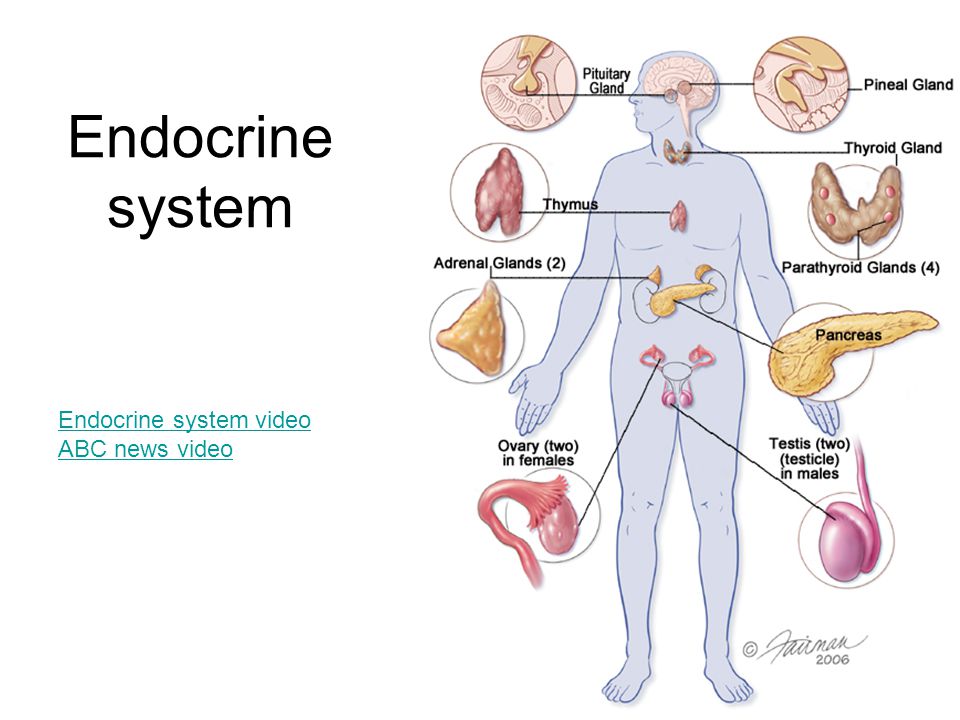 These chemical signals are sent by the endocrine organs. The endocrine organs secrete chemicals—called hormones—into the fluid outside of the tissue cells (extracellular fluid). Hormones are then transported primarily via the bloodstream throughout the body, where they bind to receptors on target cells, creating a particular response. For example, the hormones released when you are presented with a dangerous or a frightening situation, called the fight-or-flight response, occurs through the release of hormones from the adrenal gland—epinephrine and norepinephrine—within seconds. In contrast, it may take up to 48 hours for target cells to respond to certain reproductive hormones.
These chemical signals are sent by the endocrine organs. The endocrine organs secrete chemicals—called hormones—into the fluid outside of the tissue cells (extracellular fluid). Hormones are then transported primarily via the bloodstream throughout the body, where they bind to receptors on target cells, creating a particular response. For example, the hormones released when you are presented with a dangerous or a frightening situation, called the fight-or-flight response, occurs through the release of hormones from the adrenal gland—epinephrine and norepinephrine—within seconds. In contrast, it may take up to 48 hours for target cells to respond to certain reproductive hormones.
In addition, endocrine signaling is typically less specific than neural (nerve) signaling. The same hormone may also play a role in a variety of different physiological processes depending on the target cells involved. For example, the hormone oxytocin generates uterine contractions in women who are in labour.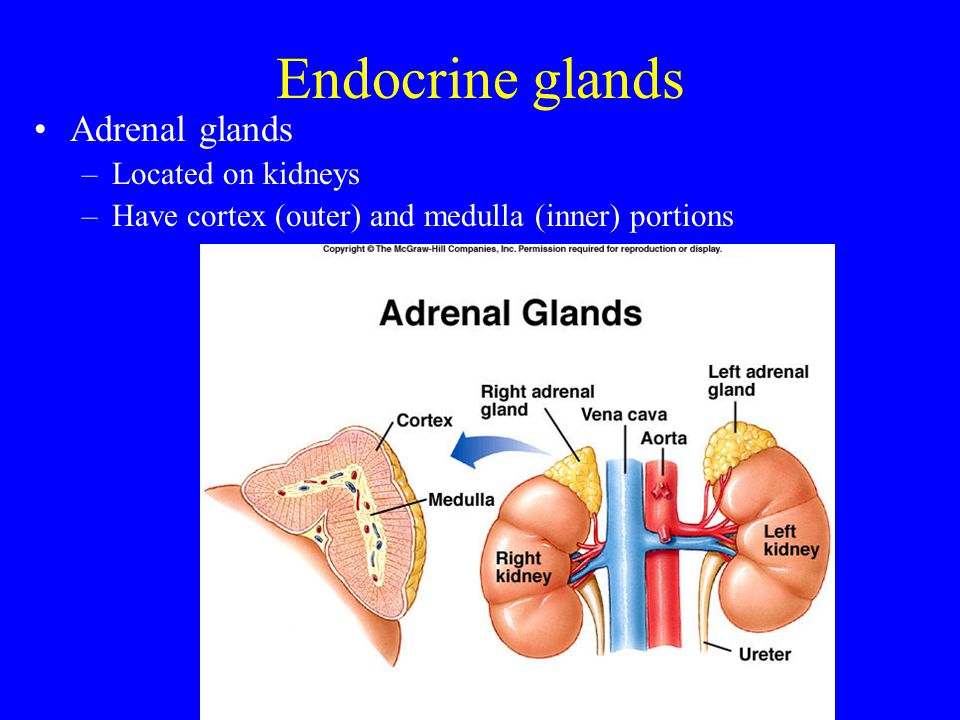 This hormone is also important in generating the milk release reflex during breastfeeding, and may be involved in the sexual response and in feelings of emotional attachment in both males and females.
This hormone is also important in generating the milk release reflex during breastfeeding, and may be involved in the sexual response and in feelings of emotional attachment in both males and females.
Generally, the nervous system involves quick responses to rapid changes in the external environment, and the endocrine system is usually slower acting—taking care of the internal environment of the body, maintaining equilibrium (homeostasis), and in controlling reproduction (see Table 20.1). So how does the fight-or-flight response, that was mentioned earlier, happen so quickly if hormones are usually slower acting? It is because the two systems are connected. It is the fast action of the nervous system in response to the danger in the environment that stimulates the adrenal glands to secrete their hormones, epinephrine and norepinephrine. As a result, the nervous system can cause rapid endocrine responses to keep up with sudden changes in both the external and internal environments, when necessary.
| Characteristic | Endocrine System | Nervous System |
|---|---|---|
| Signaling mechanism(s) | Chemical | Chemical/electrical |
| Primary chemical signal | Hormones | Neurotransmitters |
| Distance traveled | Long or short | Always short |
| Response time | Fast or slow | Always fast |
| Environment targeted | Internal | Internal and external |
Other Types of Chemical Signaling
There are four different types of chemical signaling occurring in multicellular organisms: endocrine signaling, autocrine signaling, paracrine signaling, and direct signaling.
In endocrine signaling, hormones secreted into the extracellular fluid spreads into the blood or lymphatic system, and can, therefore, travel great distances throughout the body.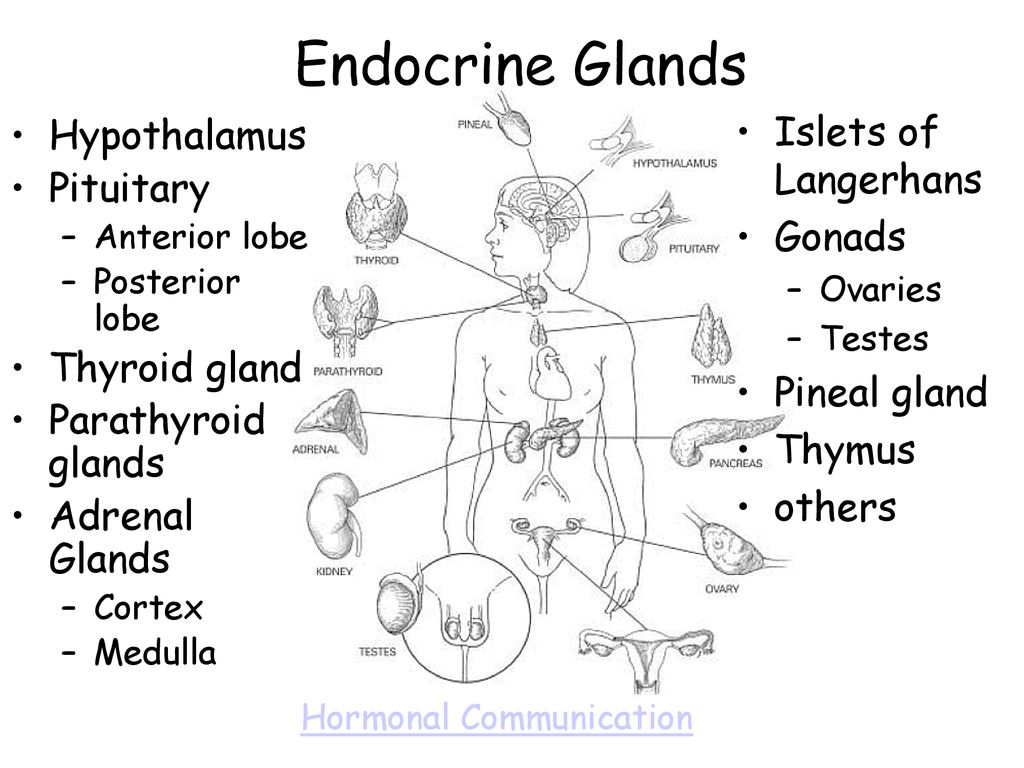
In contrast, autocrine signaling occurs within the same cell. An autocrine (auto- = “self”) is a chemical that triggers a response in the same cell that secreted the chemical. For example, Interleukin-1 (or IL-1), is a chemical signaling molecule that plays a role in inflammation. The cells that release IL-1 also have receptors on their surface that bind IL-1, resulting in autocrine signaling.
Paracrine signaling occurs amongst neighbouring cells. A paracrine (para- = “near”) is a chemical that triggers a response in neighbouring cells. Although paracrines may enter the bloodstream, their concentration is generally too low to elicit a response from distant tissues. A familiar example for those with asthma is histamine, a paracrine that is released by immune cells. Histamine causes the smooth muscle cells of the lungs to constrict, narrowing the airways.
Direct signaling occurs between neighbouring cells across gap junctions.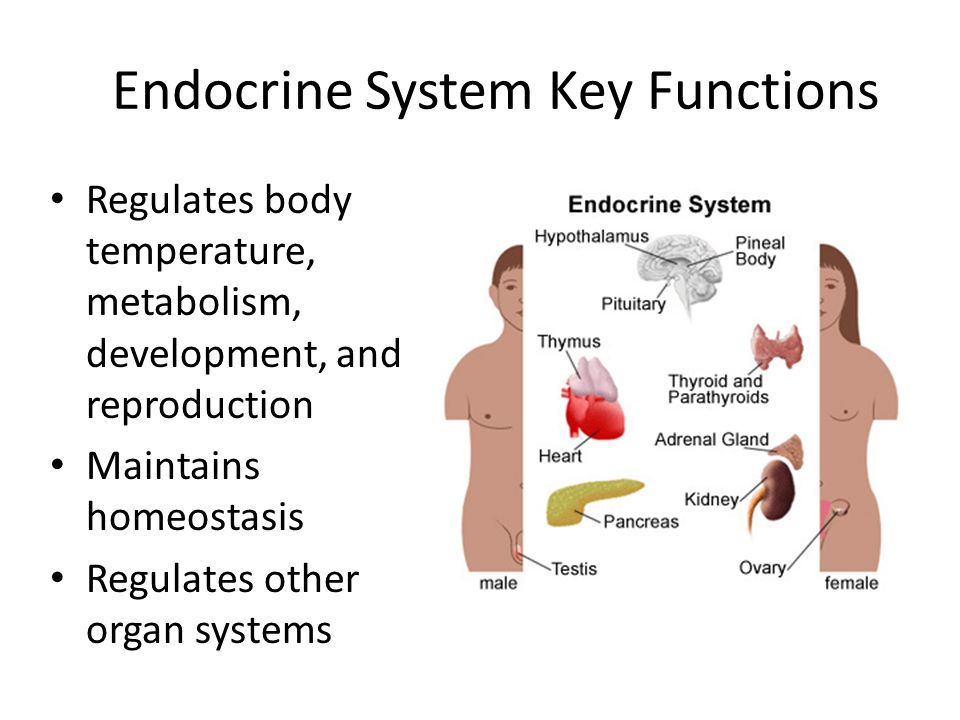 Gap junctions are channels that connect neighbouring cells, that allow small molecules to move between the neighbouring cells.
Gap junctions are channels that connect neighbouring cells, that allow small molecules to move between the neighbouring cells.
- Describe the communication methods used by the endocrine system.
- Compare and contrast endocrine and exocrine glands.
- True or false: Neurotransmitters are a special class of paracrines? Explain your answer.
Hormones
Although a given hormone may travel throughout the body in the bloodstream, it will affect the activity only of its target cells; that is, cells with receptors for that particular hormone. Once the hormone binds to the receptor, a chain of events is initiated that leads to the target cell’s response. Hormones play a critical role in the regulation of physiological processes because of the target cell responses they regulate. These responses contribute to human reproduction, growth and development of body tissues, metabolism, fluid, and electrolyte balance, sleep, and many other body functions. The major hormones of the human body and their effects are identified in Table 20.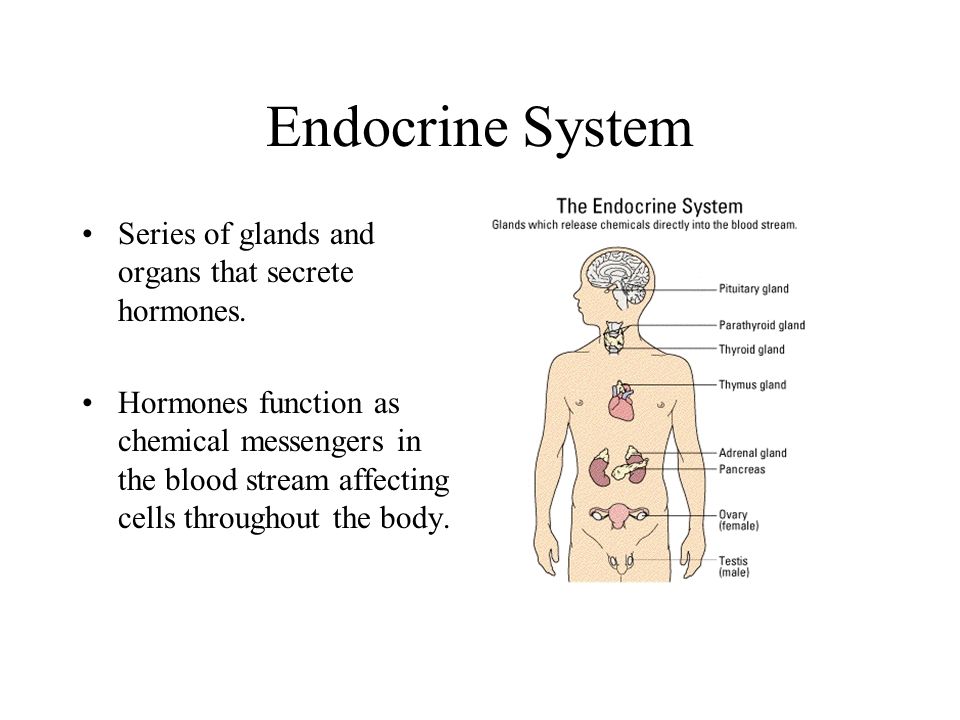 2.
2.
| Endocrine Gland | Associated Hormones | Chemical Class | Effect |
|---|---|---|---|
| Pituitary (anterior) | Growth hormone (GH) | Protein | Promotes growth of body tissues |
| Pituitary (anterior) | Prolactin (PRL) | Peptide | Promotes milk production |
| Pituitary (anterior) | Thyroid-stimulating hormone (TSH) | Glycoprotein | Stimulates thyroid hormone release |
| Pituitary (anterior) | Adrenocorticotropic hormone (ACTH) | Peptide | Stimulates hormone release by adrenal cortex |
| Pituitary (anterior) | Follicle-stimulating hormone (FSH) | Glycoprotein | Stimulates gamete production |
| Pituitary (anterior) | Luteinizing hormone (LH) | Glycoprotein | Stimulates androgen production by gonads |
| Pituitary (posterior) | Antidiuretic hormone (ADH) | Peptide | Stimulates water reabsorption by kidneys |
| Pituitary (posterior) | Oxytocin | Peptide | Stimulates uterine contractions during childbirth |
| Thyroid | Thyroxine (T4), triiodothyronine (T3) | Amine | Stimulate basal metabolic rate |
| Thyroid | Calcitonin | Peptide | Reduces blood Ca2+ levels |
| Parathyroid | Parathyroid hormone (PTH) | Peptide | Increases blood Ca2+ levels |
| Adrenal (cortex) | Aldosterone | Steroid | Increases blood Na+ levels |
| Adrenal (cortex) | Cortisol, corticosterone, cortisone | Steroid | Increase blood glucose levels |
| Adrenal (medulla) | Epinephrine, norepinephrine | Amine | Stimulate fight-or-flight response |
| Pineal | Melatonin | Amine | Regulates sleep cycles |
| Pancreas | Insulin | Protein | Reduces blood glucose levels |
| Pancreas | Glucagon | Protein | Increases blood glucose levels |
| Testes | Testosterone | Steroid | Stimulates development of male secondary sex characteristics and sperm production |
| Ovaries | Estrogens and progesterone | Steroid | Stimulate development of female secondary sex characteristics and prepare the body for childbirth |
Types of Hormones
The hormones of the human body can be divided into two major groups on the basis of their chemical structure. Hormones derived from amino acids include amines, peptides, and proteins. Those derived from lipids include steroids (see Table 20.3). These chemical groups affect a hormone’s distribution, the type of receptors it binds to, and other aspects of its function.
Hormones derived from amino acids include amines, peptides, and proteins. Those derived from lipids include steroids (see Table 20.3). These chemical groups affect a hormone’s distribution, the type of receptors it binds to, and other aspects of its function.
| HORMONE CLASS | COMPONENTS | EXAMPLES |
| Amine Hormone | Amino acids with modified groups (e.g. norepinephrine’s carboxyl group is replaced with a benezene ring) | Norepinephrine cellular structure. |
| Peptide Hormone | Short chains of linked amino acids | Oxytocin cellular structure. |
| Protein Hormone | Long chains of linked amino acides | Human growth hormone illustration.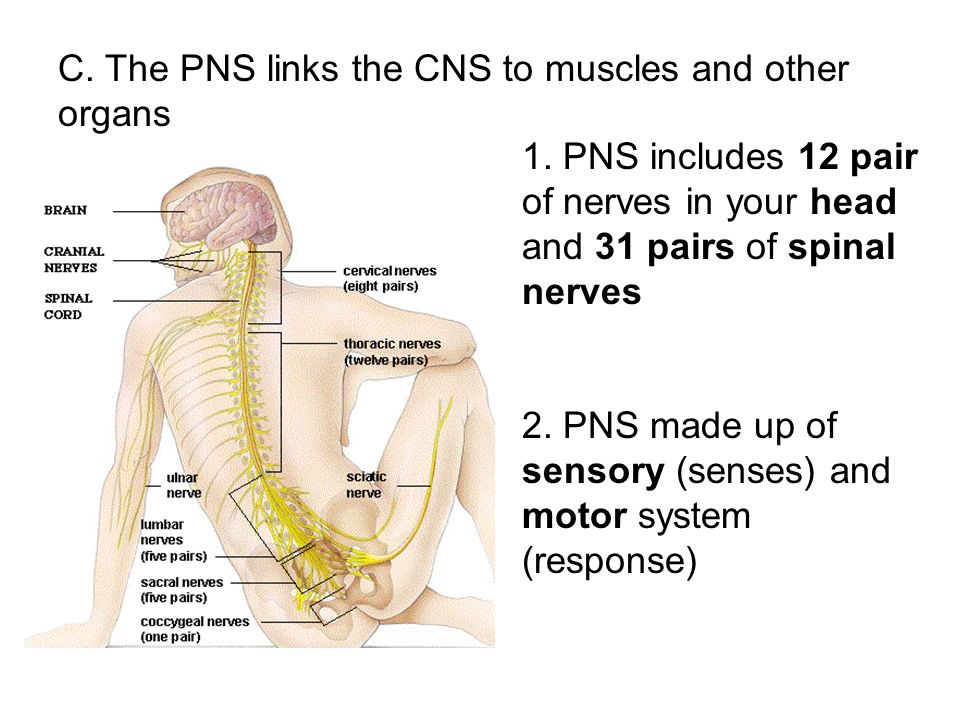 |
| Steroid Hormones | Derived from 4ipid cholesterol | Testosterone and progesterone cellular structure. |
Amine Hormones
Hormones derived from the modification of amino acids are referred to as amine hormones. Amine hormones are synthesized from the amino acids tryptophan or tyrosine. An example of a hormone derived from tryptophan is melatonin, which is secreted by the pineal gland and helps regulate circadian rhythm.
Peptide and Protein Hormones
Whereas the amine hormones are derived from a single amino acid, peptide and protein hormones consist of multiple amino acids that link to form an amino acid chain. Examples of peptide hormones include antidiuretic hormone (ADH), a pituitary hormone important in fluid balance. Some examples of protein hormones include growth hormone, which is produced by the pituitary gland, and follicle-stimulating hormone (FSH). FSH helps stimulate the maturation of eggs in the ovaries and sperm in the testes.
Steroid Hormones
The primary hormones derived from lipids are steroids. Steroid hormones are derived from the lipid cholesterol. For example, the reproductive hormones testosterone and the estrogens—which are produced by the gonads (testes and ovaries)—are steroid hormones. The adrenal glands produce the steroid hormone aldosterone, which is involved in osmoregulation, and cortisol, which plays a role in metabolism.
Like cholesterol, steroid hormones are not soluble in water (they are hydrophobic). Because blood is water-based, lipid-derived hormones must travel to their target cell bound to a transport protein.
Pathways of Hormone Action
The message a hormone sends is received by a hormone receptor, a protein located either inside the cell or within the cell membrane. The receptor will process the message by initiating other signaling events or cellular mechanisms that result in the target cell’s response. Hormone receptors recognize molecules with specific shapes and side groups, and respond only to those hormones that are recognized.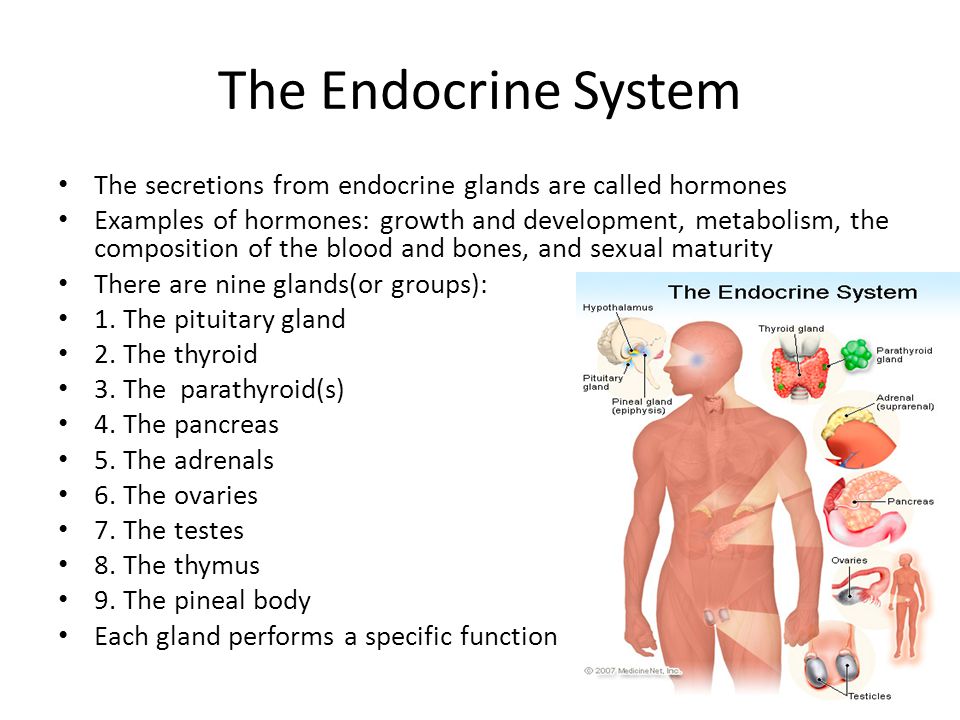 The same type of receptor may be located on cells in different body tissues, and trigger somewhat different responses. Thus, the response triggered by a hormone depends not only on the hormone, but also on the target cell.
The same type of receptor may be located on cells in different body tissues, and trigger somewhat different responses. Thus, the response triggered by a hormone depends not only on the hormone, but also on the target cell.
Once the target cell receives the hormone signal, it can respond in a variety of ways. The response may include the stimulation of protein synthesis, activation or deactivation of enzymes, alteration in the permeability of the cell membrane, altered rates of mitosis and cell growth, and stimulation of the secretion of products. Moreover, a single hormone may be capable of inducing different responses in a given cell.
Factors Affecting Target Cell Response
You will recall that target cells must have receptors specific to a given hormone if that hormone is to trigger a response. But several other factors influence the target cell response. For example, the presence of a significant level of a hormone circulating in the bloodstream can cause its target cells to decrease their number of receptors for that hormone. This process is called downregulation, and it allows cells to become less reactive to the excessive hormone levels. When the level of a hormone is chronically reduced, target cells engage in upregulation to increase their number of receptors. This process allows cells to be more sensitive to the hormone that is present. Cells can also alter the sensitivity of the receptors themselves to various hormones.
This process is called downregulation, and it allows cells to become less reactive to the excessive hormone levels. When the level of a hormone is chronically reduced, target cells engage in upregulation to increase their number of receptors. This process allows cells to be more sensitive to the hormone that is present. Cells can also alter the sensitivity of the receptors themselves to various hormones.
Two or more hormones can interact to affect the response of cells in a variety of ways. The three most common types of interaction are as follows:
- The permissive effect, in which the presence of one hormone enables another hormone to act. For example, thyroid hormones have complex permissive relationships with certain reproductive hormones. A dietary deficiency of iodine, a component of thyroid hormones, can therefore affect reproductive system development and functioning.
- The synergistic effect, in which two hormones with similar effects produce an amplified response.
 In some cases, two hormones are required for an adequate response. For example, two different reproductive hormones—FSH from the pituitary gland and estrogens from the ovaries—are required for the maturation of female ova (egg cells).
In some cases, two hormones are required for an adequate response. For example, two different reproductive hormones—FSH from the pituitary gland and estrogens from the ovaries—are required for the maturation of female ova (egg cells). - The antagonistic effect, in which two hormones have opposing effects. A familiar example is the effect of two pancreatic hormones, insulin and glucagon. Insulin increases the liver’s storage of glucose as glycogen, decreasing blood glucose, whereas glucagon stimulates the breakdown of glycogen stores, increasing blood glucose.
- Describe how a hormone receptor functions and reacts to messages received.
- Contrast upregulation and downregulation. Are both of these processes necessary? Why or why not?
Regulation of Hormone Secretion
To prevent abnormal hormone levels and a potential disease state, hormone levels must be tightly controlled. The body maintains this control by balancing hormone production and degradation. Feedback loops govern the initiation and maintenance of most hormone secretion in response to various stimuli.
Feedback loops govern the initiation and maintenance of most hormone secretion in response to various stimuli.
Role of Feedback Loops
The contribution of feedback loops to homeostasis will only be briefly reviewed here. Positive feedback loops are characterized by the release of additional hormone in response to an original hormone release. The release of oxytocin during childbirth is a positive feedback loop. The initial release of oxytocin begins to signal the uterine muscles to contract, which pushes the fetus toward the cervix, causing it to stretch. This, in turn, signals the pituitary gland to release more oxytocin, causing labor contractions to intensify. The release of oxytocin decreases after the birth of the child.
The more common method of hormone regulation is the negative feedback loop. Negative feedback is characterized by the inhibition of further secretion of a hormone in response to adequate levels of that hormone. This allows blood levels of the hormone to be regulated within a narrow range.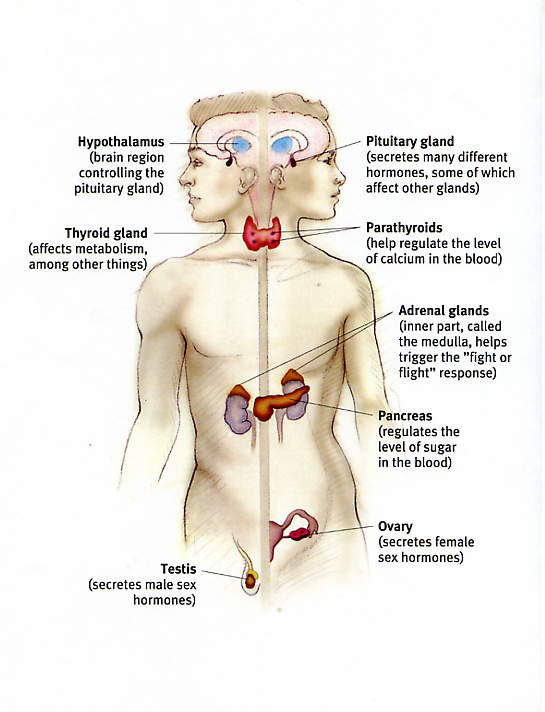 An example of a negative feedback loop is the release of glucocorticoid hormones from the adrenal glands, as directed by the hypothalamus and pituitary gland. As glucocorticoid concentrations in the blood rise, the hypothalamus and pituitary gland reduce their signaling to the adrenal glands to prevent additional glucocorticoid secretion (see Figure 20.3).
An example of a negative feedback loop is the release of glucocorticoid hormones from the adrenal glands, as directed by the hypothalamus and pituitary gland. As glucocorticoid concentrations in the blood rise, the hypothalamus and pituitary gland reduce their signaling to the adrenal glands to prevent additional glucocorticoid secretion (see Figure 20.3).
Figure 20.3 Negative Feedback Loop. The release of adrenal glucocorticoids is stimulated by the release of hormones from the hypothalamus and pituitary gland. This signaling is inhibited when glucocorticoid levels become elevated by causing negative signals to the pituitary gland and hypothalamus. From Betts, et al., 2013. Licensed under CC BY 4.0. [Image description.]
Anterior Pituitary Gland
The anterior pituitary originates from the digestive tract in the embryo and migrates toward the brain during fetal development. There are three regions: the pars distalis is the most anterior, the pars intermedia is adjacent to the posterior pituitary, and the pars tuberalis is a slender “tube” that wraps the infundibulum.
Recall that the posterior pituitary does not synthesize hormones, but merely stores them. In contrast, the anterior pituitary does manufacture hormones. However, the secretion of hormones from the anterior pituitary is regulated by two classes of hormones. These hormones—secreted by the hypothalamus—are the releasing hormones that stimulate the secretion of hormones from the anterior pituitary and the inhibiting hormones that inhibit secretion.
Hypothalamic hormones are secreted by neurons, but enter the anterior pituitary through blood vessels. Within the infundibulum is a bridge of capillaries that connects the hypothalamus to the anterior pituitary. This network, called the hypophyseal portal system, allows hypothalamic hormones to be transported to the anterior pituitary without first entering the systemic circulation. The system originates from the superior hypophyseal artery, which branches off the carotid arteries and transports blood to the hypothalamus.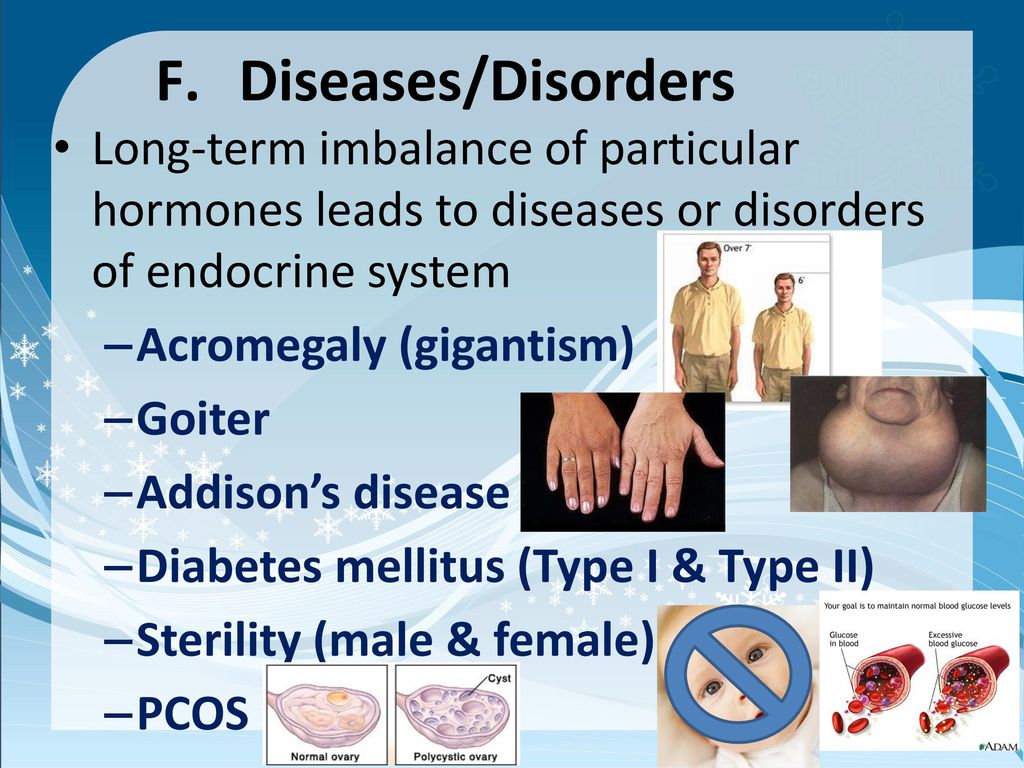 The branches of the superior hypophyseal artery form the hypophyseal portal system (see Figure 20.4). Hypothalamic releasing and inhibiting hormones travel through a primary capillary plexus to the portal veins, which carry them into the anterior pituitary. Hormones produced by the anterior pituitary (in response to releasing hormones) enter a secondary capillary plexus, and from there drain into the circulation.
The branches of the superior hypophyseal artery form the hypophyseal portal system (see Figure 20.4). Hypothalamic releasing and inhibiting hormones travel through a primary capillary plexus to the portal veins, which carry them into the anterior pituitary. Hormones produced by the anterior pituitary (in response to releasing hormones) enter a secondary capillary plexus, and from there drain into the circulation.
Figure 20.4 Anterior Pituitary. The anterior pituitary manufactures seven hormones. The hypothalamus produces separate hormones that stimulate or inhibit hormone production in the anterior pituitary. Hormones from the hypothalamus reach the anterior pituitary via the hypophyseal portal system. From Betts, et al., 2013. Licensed under CC BY 4.0. [Image description.]
The anterior pituitary produces seven hormones. These are the growth hormone (GH), thyroid-stimulating hormone (TSH), adrenocorticotropic hormone (ACTH), follicle-stimulating hormone (FSH), luteinizing hormone (LH), beta endorphin, and prolactin. Of the hormones of the anterior pituitary, TSH, ACTH, FSH, and LH are collectively referred to as tropic hormones (trope- = “turning”) because they turn on or off the function of other endocrine glands.
Of the hormones of the anterior pituitary, TSH, ACTH, FSH, and LH are collectively referred to as tropic hormones (trope- = “turning”) because they turn on or off the function of other endocrine glands.
Growth Hormone
The endocrine system regulates the growth of the human body, protein synthesis, and cellular replication. A major hormone involved in this process is growth hormone (GH), also called somatotropin—a protein hormone produced and secreted by the anterior pituitary gland. Its primary function is anabolic; it promotes protein synthesis and tissue building through direct and indirect mechanisms (see Figure 20.5). GH levels are controlled by the release of GHRH and GHIH (also known as somatostatin) from the hypothalamus.
Figure 20.5 Hormonal Regulation of Growth. Growth hormone (GH) directly accelerates the rate of protein synthesis in skeletal muscle and bones. Insulin-like growth factor 1 (IGF-1) is activated by growth hormone and indirectly supports the formation of new proteins in muscle cells and bone. From Betts, et al., 2013. Licensed under CC BY 4.0. [Image description.]
From Betts, et al., 2013. Licensed under CC BY 4.0. [Image description.]
A glucose-sparing effect occurs when GH stimulates lipolysis, or the breakdown of adipose tissue, releasing fatty acids into the blood. As a result, many tissues switch from glucose to fatty acids as their main energy source, which means that less glucose is taken up from the bloodstream.
GH also initiates the diabetogenic effect in which GH stimulates the liver to break down glycogen to glucose, which is then deposited into the blood. The name “diabetogenic” is derived from the similarity in elevated blood glucose levels observed between individuals with untreated diabetes mellitus and individuals experiencing GH excess. Blood glucose levels rise as the result of a combination of glucose-sparing and diabetogenic effects.
GH indirectly mediates growth and protein synthesis by triggering the liver and other tissues to produce a group of proteins called insulin-like growth factors (IGFs).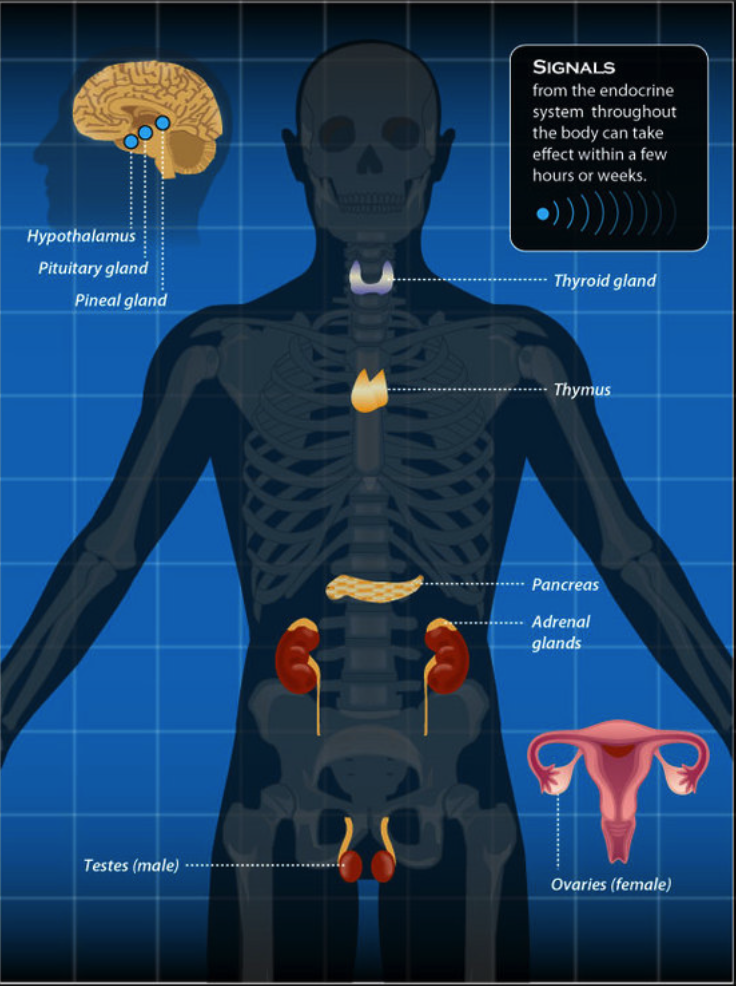 These proteins enhance cellular proliferation and inhibit apoptosis, or programmed cell death. IGFs stimulate cells to increase their uptake of amino acids from the blood for protein synthesis. Skeletal muscle and cartilage cells are particularly sensitive to stimulation from IGFs.
These proteins enhance cellular proliferation and inhibit apoptosis, or programmed cell death. IGFs stimulate cells to increase their uptake of amino acids from the blood for protein synthesis. Skeletal muscle and cartilage cells are particularly sensitive to stimulation from IGFs.
Dysfunction of the endocrine system’s control of growth can result in several disorders. For example, gigantism is a disorder in children that is caused by the secretion of abnormally large amounts of GH, resulting in excessive growth. A similar condition in adults is acromegaly, a disorder that results in the growth of bones in the face, hands, and feet in response to excessive levels of GH in individuals who have stopped growing. Abnormally low levels of GH in children can cause growth impairment—a disorder called pituitary dwarfism (also known as growth hormone deficiency).
Posterior Pituitary Gland
The posterior pituitary is actually an extension of the neurons of the nuclei of the hypothalamus.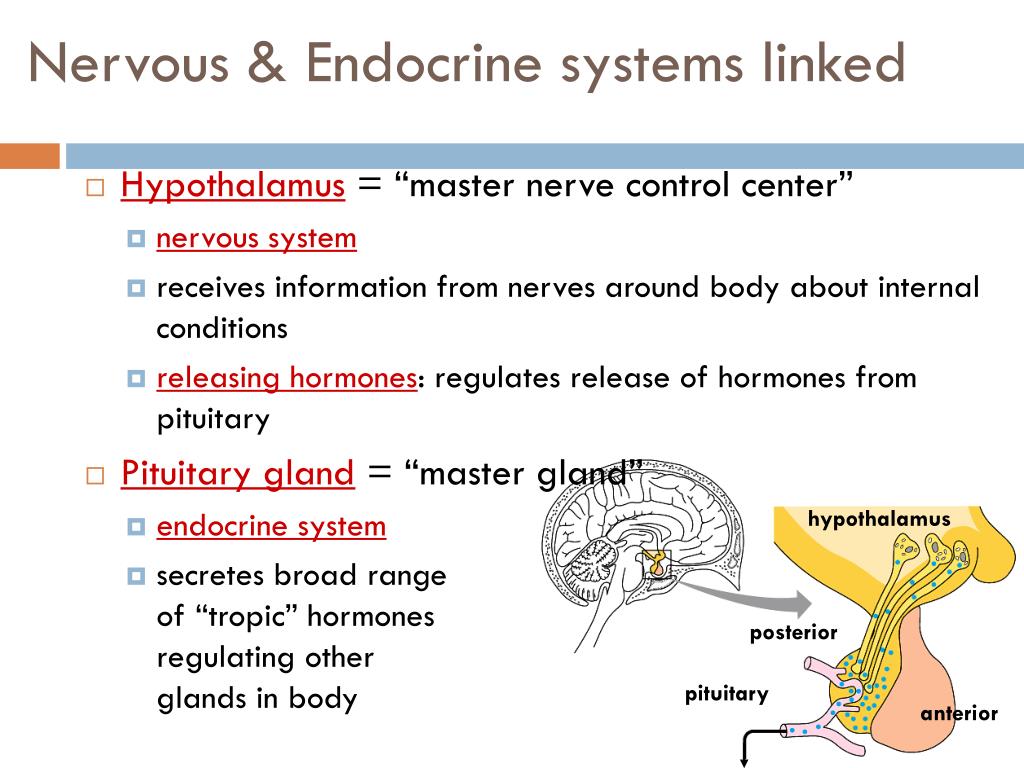 The cell bodies of these regions rest in the hypothalamus, but their axons descend as the hypothalamic–hypophyseal tract within the infundibulum, and end in axon terminals that comprise the posterior pituitary (see Figure 20.6).
The cell bodies of these regions rest in the hypothalamus, but their axons descend as the hypothalamic–hypophyseal tract within the infundibulum, and end in axon terminals that comprise the posterior pituitary (see Figure 20.6).
Figure 20.6 Posterior Pituitary. Neurosecretory cells in the hypothalamus release oxytocin (OT) or ADH into the posterior lobe of the pituitary gland. These hormones are stored or released into the blood via the capillary plexus. From Betts, et al., 2013. Licensed under CC BY 4.0. [Image description.]
The posterior pituitary gland does not produce hormones, but rather stores and secretes hormones produced by the hypothalamus. The paraventricular nuclei produce the hormone oxytocin, whereas the supraoptic nuclei produce ADH. These hormones travel along the axons into storage sites in the axon terminals of the posterior pituitary. In response to signals from the same hypothalamic neurons, the hormones are released from the axon terminals into the bloodstream.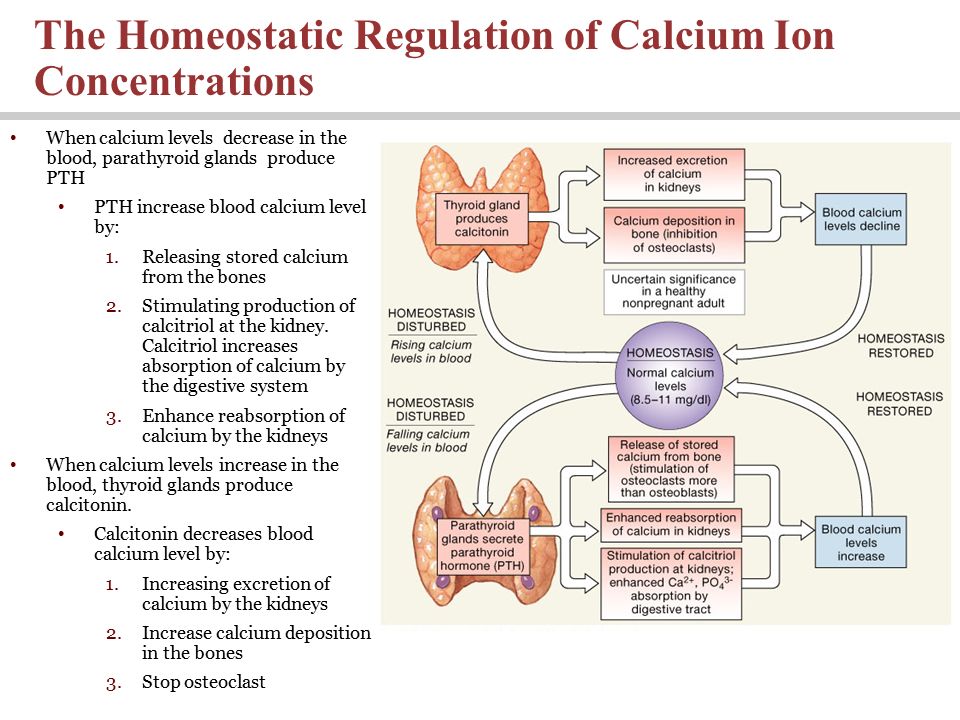
Oxytocin
When fetal development is complete, the peptide-derived hormone oxytocin (tocia- = “childbirth”) stimulates uterine contractions and dilation of the cervix. Throughout most of pregnancy, oxytocin hormone receptors are not expressed at high levels in the uterus. Toward the end of pregnancy, the synthesis of oxytocin receptors in the uterus increases, and the smooth muscle cells of the uterus become more sensitive to its effects. Oxytocin is continually released throughout childbirth through a positive feedback mechanism. As noted earlier, oxytocin prompts uterine contractions that push the fetal head toward the cervix. In response, cervical stretching stimulates additional oxytocin to be synthesized by the hypothalamus and released from the pituitary. This increases the intensity and effectiveness of uterine contractions and prompts additional dilation of the cervix. The feedback loop continues until birth.
Although the mother’s high blood levels of oxytocin begin to decrease immediately following birth, oxytocin continues to play a role in maternal and newborn health.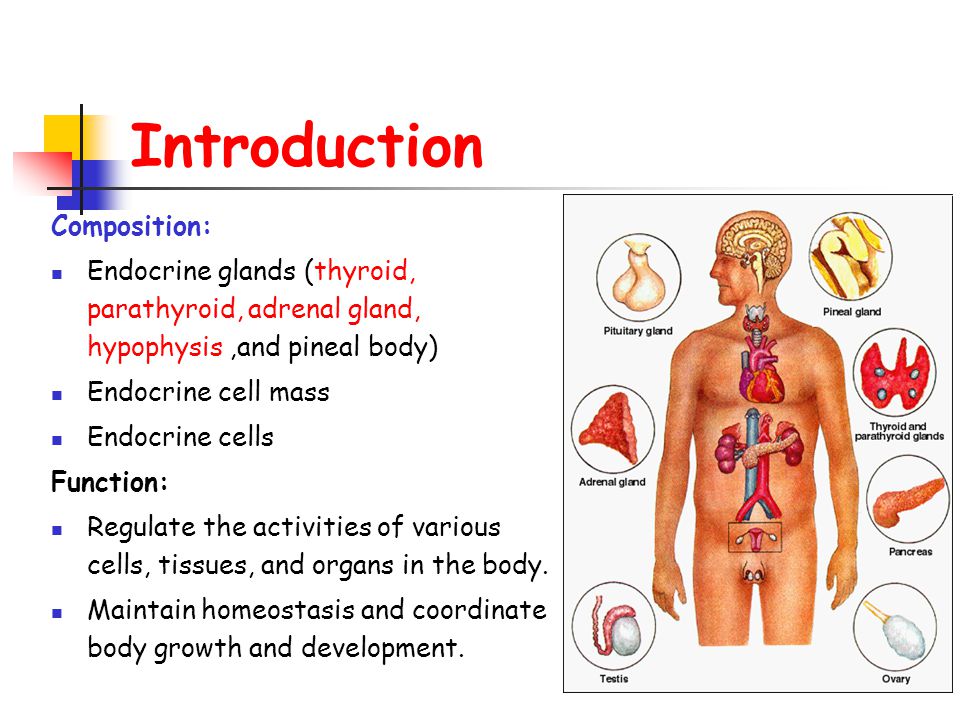 First, oxytocin is necessary for the milk ejection reflex (commonly referred to as “let-down”) in breastfeeding women. As the newborn begins suckling, sensory receptors in the nipples transmit signals to the hypothalamus. In response, oxytocin is secreted and released into the bloodstream. Within seconds, cells in the mother’s milk ducts contract, ejecting milk into the infant’s mouth. Secondly, in both males and females, oxytocin is thought to contribute to parent–newborn bonding, known as attachment. Oxytocin is also thought to be involved in feelings of love and closeness, as well as in the sexual response.
First, oxytocin is necessary for the milk ejection reflex (commonly referred to as “let-down”) in breastfeeding women. As the newborn begins suckling, sensory receptors in the nipples transmit signals to the hypothalamus. In response, oxytocin is secreted and released into the bloodstream. Within seconds, cells in the mother’s milk ducts contract, ejecting milk into the infant’s mouth. Secondly, in both males and females, oxytocin is thought to contribute to parent–newborn bonding, known as attachment. Oxytocin is also thought to be involved in feelings of love and closeness, as well as in the sexual response.
Antidiuretic Hormone (ADH)
The solute concentration of the blood, or blood osmolarity, may change in response to the consumption of certain foods and fluids, as well as in response to disease, injury, medications, or other factors. Blood osmolarity is constantly monitored by osmoreceptors—specialized cells within the hypothalamus that are particularly sensitive to the concentration of sodium ions and other solutes.
In response to high blood osmolarity, which can occur during dehydration or following a very salty meal, the osmoreceptors signal the posterior pituitary to release antidiuretic hormone (ADH). The target cells of ADH are located in the tubular cells of the kidneys. Its effect is to increase epithelial permeability to water, allowing increased water reabsorption. The more water reabsorbed from the filtrate, the greater the amount of water that is returned to the blood and the less that is excreted in the urine. A greater concentration of water results in a reduced concentration of solutes. ADH is also known as vasopressin because, in very high concentrations, it causes constriction of blood vessels, which increases blood pressure by increasing peripheral resistance. The release of ADH is controlled by a negative feedback loop. As blood osmolarity decreases, the hypothalamic osmoreceptors sense the change and prompt a corresponding decrease in the secretion of ADH. As a result, less water is reabsorbed from the urine filtrate.
As a result, less water is reabsorbed from the urine filtrate.
Interestingly, drugs can affect the secretion of ADH. For example, alcohol consumption inhibits the release of ADH, resulting in increased urine production that can eventually lead to dehydration and a hangover. A disease called diabetes insipidus is characterized by chronic underproduction of ADH that causes chronic dehydration. Because little ADH is produced and secreted, not enough water is reabsorbed by the kidneys. Although patients feel thirsty, and increase their fluid consumption, this doesn’t effectively decrease the solute concentration in their blood because ADH levels are not high enough to trigger water reabsorption in the kidneys. Electrolyte imbalances can occur in severe cases of diabetes insipidus.
Thyroid-Stimulating Hormone
The activity of the thyroid gland is regulated by thyroid-stimulating hormone (TSH), also called thyrotropin. TSH is released from the anterior pituitary in response to thyrotropin-releasing hormone (TRH) from the hypothalamus. As discussed shortly, it triggers the secretion of thyroid hormones by the thyroid gland. In a classic negative feedback loop, elevated levels of thyroid hormones in the bloodstream then trigger a drop in production of TRH and subsequently TSH.
As discussed shortly, it triggers the secretion of thyroid hormones by the thyroid gland. In a classic negative feedback loop, elevated levels of thyroid hormones in the bloodstream then trigger a drop in production of TRH and subsequently TSH.
Adrenocorticotropic Hormone
The adrenocorticotropic hormone (ACTH), also called corticotropin, stimulates the adrenal cortex (the more superficial “bark” of the adrenal glands) to secrete corticosteroid hormones such as cortisol. ACTH come from a precursor molecule known as pro-opiomelanotropin (POMC) which produces several biologically active molecules when cleaved, including ACTH, melanocyte-stimulating hormone, and the brain opioid peptides known as endorphins. The release of ACTH is regulated by the corticotropin-releasing hormone (CRH) from the hypothalamus in response to normal physiologic rhythms. A variety of stressors can also influence its release, and the role of ACTH in the stress response is discussed later in this chapter.
Follicle-Stimulating Hormone and Luteinizing Hormone
The endocrine glands secrete a variety of hormones that control the development and regulation of the reproductive system (these glands include the anterior pituitary, the adrenal cortex, and the gonads—the testes in males and the ovaries in females). Much of the development of the reproductive system occurs during puberty and is marked by the development of sex-specific characteristics in both male and female adolescents. Puberty is initiated by gonadotropin-releasing hormone (GnRH), a hormone produced and secreted by the hypothalamus. GnRH stimulates the anterior pituitary to secrete gonadotropins—hormones that regulate the function of the gonads. The levels of GnRH are regulated through a negative feedback loop; high levels of reproductive hormones inhibit the release of GnRH. Throughout life, gonadotropins regulate reproductive function and, in the case of women, the onset and cessation of reproductive capacity.
The gonadotropins include two glycoprotein hormones: follicle-stimulating hormone (FSH) stimulates the production and maturation of sex cells, or gametes, including ova in women and sperm in men. FSH also promotes follicular growth; these follicles then release estrogens in the female ovaries. Luteinizing hormone (LH) triggers ovulation in women, as well as the production of estrogens and progesterone by the ovaries. LH stimulates production of testosterone by the male testes.
Prolactin
As its name implies, prolactin (PRL) promotes lactation (milk production) in women. During pregnancy, it contributes to development of the mammary glands, and after birth, it stimulates the mammary glands to produce breast milk. However, the effects of prolactin depend heavily upon the permissive effects of estrogens, progesterone, and other hormones. And as noted earlier, the let-down of milk occurs in response to stimulation from oxytocin.
In a non-pregnant woman, prolactin secretion is inhibited by prolactin-inhibiting hormone (PIH), which is actually the neurotransmitter dopamine, and is released from neurons in the hypothalamus. Only during pregnancy do prolactin levels rise in response to prolactin-releasing hormone (PRH) from the hypothalamus.
Intermediate Pituitary: Melanocyte-Stimulating Hormone
The cells in the zone between the pituitary lobes secrete a hormone known as melanocyte-stimulating hormone (MSH) that is formed by cleavage of the pro-opiomelanocortin (POMC) precursor protein. Local production of MSH in the skin is responsible for melanin production in response to UV light exposure. The role of MSH made by the pituitary is more complicated. For instance, people with lighter skin generally have the same amount of MSH as people with darker skin. Nevertheless, this hormone is capable of darkening of the skin by inducing melanin production in the skin’s melanocytes. Women also show increased MSH production during pregnancy; in combination with estrogens, it can lead to darker skin pigmentation, especially the skin of the areolas and labia minora.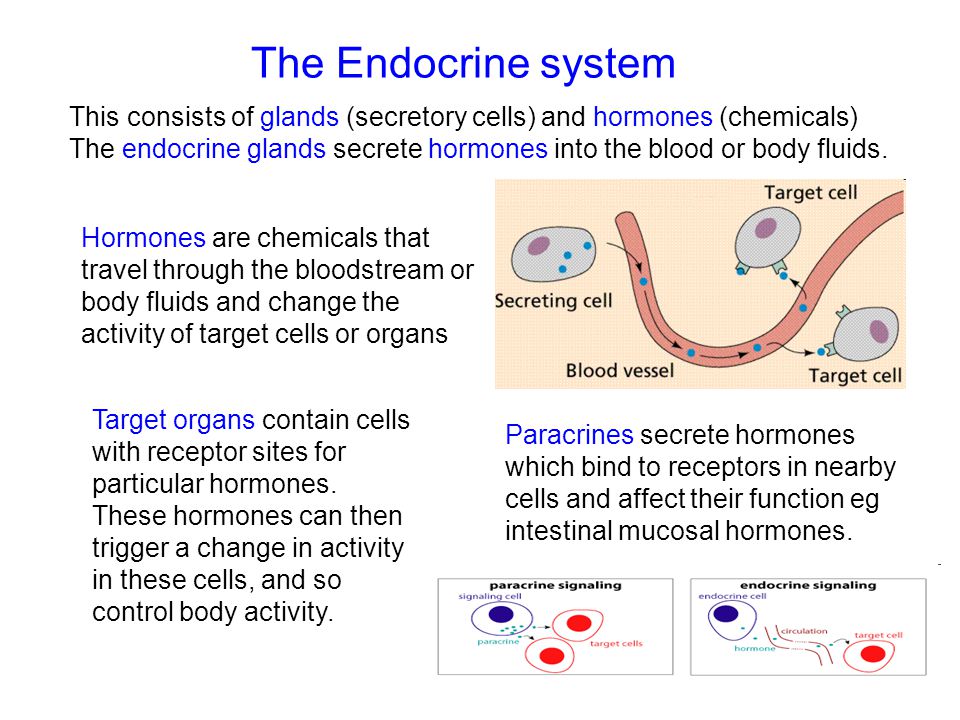 Table 20.4 is a summary of the pituitary hormones and their principal effects.
Table 20.4 is a summary of the pituitary hormones and their principal effects.
| IMAGE OF GLANDS | HORMONES | |||
| An image displaying the posterior pituitary gland | Posterior Pituitary Hormones | |||
| Releasing hormone (hypothalamus) | Pituitary Hormone | Target | Effects | |
| ADH | Stores ADH | Kidneys, sweat glands, circulatory system | Water balance | |
| – | OT | Female reproductive system | Triggers uterine contractions during childbirth | |
| An image displaying the Anterior Pituitary Gland | Anterior Pituitary Hormones | |||
| Releasing hormone (hypothalamus) | Pituitary Hormone | Target | Effects | |
| GnRH | LH | Reproductive system | Stimulates production of sex hormones by gonads | |
| GnRH | FSH | Reproductive system | stimulates production of sperm and eggs | |
| TRH | TSH | Thyroid gland | STimulates the release of thyroid hormone (TH), TH regulates metabolism | |
| PRH (inhibited by PIH) | PRL | Mammary glands | Promotes milk production | |
| GHRH (inhibited by GHIH) | GH | Liver, bone, muscles | Induces targets to produce insulin-like growth factors (IGF). IGFs stimulate body growth and higher metabolic rate. IGFs stimulate body growth and higher metabolic rate. | |
| CRH | ACTH | Adrenal glands | Induces targets to produce glucocorticoids, which regulate metabolism and stress response | |
Pineal Gland
A tiny endocrine gland whose functions are not entirely clear. The pinealocyte cells that make up the pineal gland are known to produce and secrete the amine hormone melatonin, which is derived from serotonin.
The secretion of melatonin varies according to the level of light received from the environment. When photons of light stimulate the retinas of the eyes, a nerve impulse is sent to a region of the hypothalamus which is important in regulating biological rhythms. When blood levels of melatonin fall they promote wakefulness. In contrast, as light levels decline—such as during the evening—melatonin production increases, boosting blood levels and causing drowsiness.
Watch this video:
youtube.com/embed/EUyBDGgsk_I?feature=oembed&rel=0″ frameborder=”0″ allowfullscreen=”allowfullscreen”/>
Media 20.2 What Does Melatonin Do? Melatonin Use Info [Online video]. Copyright 2015 by Travelers Defense.
What should you avoid doing in the middle of your sleep cycle that would lower melatonin?
The secretion of melatonin may influence the body’s circadian rhythms, the dark-light fluctuations that affect not only sleepiness and wakefulness, but also appetite and body temperature. Interestingly, children have higher melatonin levels than adults, which may prevent the release of gonadotropins from the anterior pituitary, thereby inhibiting the onset of puberty. Finally, an antioxidant role of melatonin is the subject of current research.
Jet lag occurs when a person travels across several time zones and feels sleepy during the day or wakeful at night. Traveling across multiple time zones significantly disturbs the light-dark cycle regulated by melatonin. It can take up to several days for melatonin synthesis to adjust to the light-dark patterns in the new environment, resulting in jet lag. Some air travelers take melatonin supplements to induce sleep.
Thyroid Gland
A butterfly-shaped organ, the thyroid gland is located anterior to the trachea, just inferior to the larynx (see Figure 20.7). The medial region, called the isthmus, is flanked by wing-shaped left and right lobes. Each of the thyroid lobes are embedded with parathyroid glands, primarily on their posterior surfaces. The tissue of the thyroid gland is composed mostly of thyroid follicles. The follicles are made up of a central cavity filled with a sticky fluid called colloid. Surrounded by a wall of epithelial follicle cells, the colloid is the center of thyroid hormone production, and that production is dependent on the hormones’ essential and unique component: iodine.
Figure 20.7 Thyroid Gland. The thyroid gland is located in the neck where it wraps around the trachea. (a) Anterior view of the thyroid gland. (b) Posterior view of the thyroid gland. (c) The glandular tissue is composed primarily of thyroid follicles. The larger parafollicular cells often appear within the matrix of follicle cells. LM × 1332. (Micrograph provided by the Regents of University of Michigan Medical School © 2012). From Betts, et al., 2013. Licensed under CC BY 4.0. [Image description.]
Regulation of TH Synthesis
The release of T3 and T4 from the thyroid gland is regulated by thyroid-stimulating hormone (TSH). Low blood levels of T3 and T4 stimulate the release of thyrotropin-releasing hormone (TRH) from the hypothalamus, which triggers secretion of TSH from the anterior pituitary. In turn, TSH stimulates the thyroid gland to secrete T3 and T4. The levels of TRH, TSH, T3, and T4 are regulated by a negative feedback system in which increasing levels of T3 and T4 decrease the production and secretion of TSH. The thyroid hormones, T3 and T4, are often referred to as metabolic hormones because their levels influence the body’s basal metabolic rate, the amount of energy used by the body at rest.
The thyroid gland also secretes a hormone called calcitonin that is produced by the parafollicular cells (also called C cells) that stud the tissue between distinct follicles. Calcitonin is released in response to a rise in blood calcium levels.
Parathyroid Gland
The parathyroid glands are tiny, round structures usually found embedded in the posterior surface of the thyroid gland. A thick connective tissue capsule separates the glands from the thyroid tissue. Most people have four parathyroid glands, but occasionally there are more in tissues of the neck or chest. The function of one type of parathyroid cells, the oxyphil cells, is not clear. The primary functional cells of the parathyroid glands are the chief cells. These epithelial cells produce and secrete the parathyroid hormone (PTH), the major hormone involved in the regulation of blood calcium levels.
Adrenal Gland
The adrenal glands are wedges of glandular and neuroendocrine tissue adhering to the top of the kidneys by a fibrous capsule (see Figure 20.8). The adrenal glands have a rich blood supply and experience one of the highest rates of blood flow in the body. They are served by several arteries branching off the aorta, including the suprarenal and renal arteries. Blood flows to each adrenal gland at the adrenal cortex and then drains into the adrenal medulla. Adrenal hormones are released into the circulation via the left and right suprarenal veins.
Figure 20.8 Adrenal Glands. Both adrenal glands sit atop the kidneys and are composed of an outer cortex and an inner medulla, all surrounded by a connective tissue capsule. The cortex can be subdivided into additional zones, all of which produce different types of hormones. LM × 204. (Micrograph provided by the Regents of University of Michigan Medical School © 2012). From Betts, et al., 2013. Licensed under CC BY 4.0. [Image description.]
The adrenal cortex, as a component of the hypothalamic-pituitary-adrenal (HPA) axis, secretes steroid hormones important for the regulation of the long-term stress response, blood pressure and blood volume, nutrient uptake and storage, fluid and electrolyte balance, and inflammation. The HPA axis involves the stimulation of hormone release of adrenocorticotropic hormone (ACTH) from the pituitary by the hypothalamus. ACTH then stimulates the adrenal cortex to produce the hormone cortisol. This pathway will be discussed in more detail below.
The adrenal medulla is neuroendocrine tissue composed of postganglionic sympathetic nervous system (SNS) neurons. It is really an extension of the autonomic nervous system, which regulates homeostasis in the body. The sympathomedullary (SAM) pathway involves the stimulation of the medulla by impulses from the hypothalamus via neurons from the thoracic spinal cord. The medulla is stimulated to secrete the amine hormones epinephrine and norepinephrine.
One of the major functions of the adrenal gland is to respond to stress. Stress can be either physical or psychological or both. Physical stresses include exposing the body to injury, walking outside in cold and wet conditions without a coat on, or malnutrition. Psychological stresses include the perception of a physical threat, a fight with a loved one, or just a bad day at school.
The body responds in different ways to short-term stress and long-term stress following a pattern known as the general adaptation syndrome (GAS). Stage one of GAS is called the alarm reaction. This is short-term stress, the fight-or-flight response, mediated by the hormones epinephrine and norepinephrine from the adrenal medulla via the SAM pathway. Their function is to prepare the body for extreme physical exertion. Once this stress is relieved, the body quickly returns to normal. The section on the adrenal medulla covers this response in more detail.
If the stress is not soon relieved, the body adapts to the stress in the second stage called the stage of resistance. If a person is starving for example, the body may send signals to the gastrointestinal tract to maximize the absorption of nutrients from food.
If the stress continues for a longer term however, the body responds with symptoms quite different than the fight-or-flight response. During the stage of exhaustion, individuals may begin to suffer depression, the suppression of their immune response, severe fatigue, or even a fatal heart attack. These symptoms are mediated by the hormones of the adrenal cortex, especially cortisol, released as a result of signals from the HPA axis.
Adrenal hormones also have several non–stress-related functions, including the increase of blood sodium and glucose levels, which will be described in detail below.
Adrenal Cortex
The adrenal cortex consists of multiple layers of lipid-storing cells that occur in three structurally distinct regions. Each of these regions produces different hormones.
Watch this video:
Media 20.3 Endocrine System, Part 2 – Hormone Cascades: Crash Course A&P #24 [Online video]. Copyright 2015 by CrashCourse.
- Which hormone produced by the adrenal glands is responsible for the mobilization of energy stores?
Hormones of the Zona Glomerulosa
The most superficial region of the adrenal cortex is the zona glomerulosa, which produces a group of hormones collectively referred to as mineralocorticoids because of their effect on body minerals, especially sodium and potassium. These hormones are essential for fluid and electrolyte balance.
Aldosterone is the major mineralocorticoid. It is important in the regulation of the concentration of sodium and potassium ions in urine, sweat, and saliva. For example, it is released in response to elevated blood K+, low blood Na+, low blood pressure, or low blood volume. In response, aldosterone increases the excretion of K+ and the retention of Na+, which in turn increases blood volume and blood pressure. Its secretion is prompted when CRH from the hypothalamus triggers ACTH release from the anterior pituitary.
Aldosterone is also a key component of the renin-angiotensin-aldosterone system (RAAS) in which specialized cells of the kidneys secrete the enzyme renin in response to low blood volume or low blood pressure. Renin then catalyzes the conversion of the blood protein angiotensinogen, produced by the liver, to the hormone angiotensin I. Angiotensin I is converted in the lungs to angiotensin II by angiotensin-converting enzyme (ACE). Angiotensin II has three major functions:
- Initiating vasoconstriction of the arterioles, decreasing blood flow
- Stimulating kidney tubules to reabsorb NaCl and water, increasing blood volume
- Signaling the adrenal cortex to secrete aldosterone, the effects of which further contribute to fluid retention, restoring blood pressure and blood volume
For individuals with hypertension, or high blood pressure, drugs are available that block the production of angiotensin II. These drugs, known as ACE inhibitors, block the ACE enzyme from converting angiotensin I to angiotensin II, thus mitigating the latter’s ability to increase blood pressure.
Hormones of the Zona Fasciculata
The intermediate region of the adrenal cortex is the zona fasciculata, named as such because the cells form small fascicles (bundles) separated by tiny blood vessels. The cells of the zona fasciculata produce hormones called glucocorticoids because of their role in glucose metabolism. The most important of these is cortisol, some of which the liver converts to cortisone. A glucocorticoid produced in much smaller amounts is corticosterone. In response to long-term stressors, the hypothalamus secretes CRH, which in turn triggers the release of ACTH by the anterior pituitary. ACTH triggers the release of the glucocorticoids. Their overall effect is to inhibit tissue building while stimulating the breakdown of stored nutrients to maintain adequate fuel supplies. In conditions of long-term stress, for example, cortisol promotes the catabolism of glycogen to glucose, the catabolism of stored triglycerides into fatty acids and glycerol, and the catabolism of muscle proteins into amino acids. These raw materials can then be used to synthesize additional glucose and ketones for use as body fuels. The hippocampus, which is part of the temporal lobe of the cerebral cortices and important in memory formation, is highly sensitive to stress levels because of its many glucocorticoid receptors.
You are probably familiar with prescription and over-the-counter medications containing glucocorticoids, such as cortisone injections into inflamed joints, prednisone tablets and steroid-based inhalers used to manage severe asthma, and hydrocortisone creams applied to relieve itchy skin rashes. These drugs reflect another role of cortisol—the downregulation of the immune system, which inhibits the inflammatory response.
Hormones of the Zona Reticularis
The deepest region of the adrenal cortex is the zona reticularis, which produces small amounts of a class of steroid sex hormones called androgens. During puberty and most of adulthood, androgens are produced in the gonads. The androgens produced in the zona reticularis supplement the gonadal androgens. They are produced in response to ACTH from the anterior pituitary and are converted in the tissues to testosterone or estrogens. In adult women, they may contribute to the sex drive, but their function in adult men is not well understood. In post-menopausal women, as the functions of the ovaries decline, the main source of estrogens becomes the androgens produced by the zona reticularis.
Adrenal Medulla
As noted earlier, the adrenal cortex releases glucocorticoids in response to long-term stress such as severe illness. In contrast, the adrenal medulla releases its hormones in response to acute, short-term stress mediated by the sympathetic nervous system (SNS).
The medullary tissue is composed of unique postganglionic SNS neurons called chromaffin cells, which are large and irregularly shaped, and produce the neurotransmitters epinephrine (also called adrenaline) and norepinephrine (or noradrenaline). Epinephrine is produced in greater quantities—approximately a 4 to 1 ratio with norepinephrine—and is the more powerful hormone. Because the chromaffin cells release epinephrine and norepinephrine into the systemic circulation, where they travel widely and exert effects on distant cells, they are considered hormones. Derived from the amino acid tyrosine, they are chemically classified as catecholamines.
The secretion of medullary epinephrine and norepinephrine is controlled by a neural pathway that originates from the hypothalamus in response to danger or stress (the SAM pathway). Both epinephrine and norepinephrine signal the liver and skeletal muscle cells to convert glycogen into glucose, resulting in increased blood glucose levels. These hormones increase the heart rate, pulse, and blood pressure to prepare the body to fight the perceived threat or flee from it. In addition, the pathway dilates the airways, raising blood oxygen levels. It also prompts vasodilation, further increasing the oxygenation of important organs such as the lungs, brain, heart, and skeletal muscle. At the same time, it triggers vasoconstriction to blood vessels serving less essential organs such as the gastrointestinal tract, kidneys, and skin, and downregulates some components of the immune system. Other effects include a dry mouth, loss of appetite, pupil dilation, and a loss of peripheral vision.
Pancreas
The pancreas is a long, slender organ, most of which is located posterior to the bottom half of the stomach (see Figure 20.9). Although it is primarily an exocrine gland, secreting a variety of digestive enzymes, the pancreas has an endocrine function. Its pancreatic islets—clusters of cells formerly known as the islets of Langerhans—secrete the hormones glucagon, insulin, somatostatin, and pancreatic polypeptide (PP).
Figure 20.9 Pancreas. The pancreatic exocrine function involves the acinar cells secreting digestive enzymes that are transported into the small intestine by the pancreatic duct. Its endocrine function involves the secretion of insulin (produced by beta cells) and glucagon (produced by alpha cells) within the pancreatic islets. These two hormones regulate the rate of glucose metabolism in the body. The micrograph reveals pancreatic islets. LM × 760. (Micrograph provided by the Regents of University of Michigan Medical School © 2012). From Betts, et al., 2013. Licensed under CC BY 4.0. [Image description.]
Cells and Secretions of the Pancreatic Islets
The pancreatic islets each contain four varieties of cells:
- The alpha cell produces the hormone glucagon and makes up approximately 20 percent of each islet. Glucagon plays an important role in blood glucose regulation; low blood glucose levels stimulate its release.
- The beta cell produces the hormone insulin and makes up approximately 75 percent of each islet. Elevated blood glucose levels stimulate the release of insulin.
- The delta cell accounts for four percent of the islet cells and secretes the peptide hormone somatostatin. Recall that somatostatin is also released by the hypothalamus (as GHIH), and the stomach and intestines also secrete it. An inhibiting hormone, pancreatic somatostatin inhibits the release of both glucagon and insulin.
- The PP cell accounts for about one percent of islet cells and secretes the pancreatic polypeptide hormone. It is thought to play a role in appetite, as well as in the regulation of pancreatic exocrine and endocrine secretions. Pancreatic polypeptide released following a meal may reduce further food consumption; however, it is also released in response to fasting.
Regulation of Blood Glucose Levels by Insulin and Glucagon
Glucose is required for cellular respiration and is the preferred fuel for all body cells. The body derives glucose from the breakdown of the carbohydrate-containing foods and drinks we consume. Glucose not immediately taken up by cells for fuel can be stored by the liver and muscles as glycogen, or converted to triglycerides and stored in the adipose tissue. Hormones regulate both the storage and the utilization of glucose as required. Receptors located in the pancreas sense blood glucose levels, and subsequently the pancreatic cells secrete glucagon or insulin to maintain normal levels.
Gonadal Glands
The male testes and female ovaries—which produce the sex cells (sperm and ova) and secrete the gonadal hormones. The roles of the gonadotropins released from the anterior pituitary (FSH and LH) were discussed earlier.
The primary hormone produced by the male testes is testosterone, a steroid hormone important in the development of the male reproductive system, the maturation of sperm cells, and the development of male secondary sex characteristics such as a deepened voice, body hair, and increased muscle mass. Interestingly, testosterone is also produced in the female ovaries, but at a much reduced level. In addition, the testes produce the peptide hormone inhibin, which inhibits the secretion of FSH from the anterior pituitary gland. FSH stimulates spermatogenesis.
The primary hormones produced by the ovaries are estrogens, which include estradiol, estriol, and estrone. Estrogens play an important role in a larger number of physiological processes, including the development of the female reproductive system, regulation of the menstrual cycle, the development of female secondary sex characteristics such as increased adipose tissue and the development of breast tissue, and the maintenance of pregnancy. Another significant ovarian hormone is progesterone, which contributes to regulation of the menstrual cycle and is important in preparing the body for pregnancy as well as maintaining pregnancy. In addition, the granulosa cells of the ovarian follicles produce inhibin, which—as in males—inhibits the secretion of FSH. During the initial stages of pregnancy, an organ called the placenta develops within the uterus. The placenta supplies oxygen and nutrients to the fetus, excretes waste products, and produces and secretes estrogens and progesterone. The placenta produces human chorionic gonadotropin (hCG) as well. The hCG hormone promotes progesterone synthesis and reduces the mother’s immune function to protect the fetus from immune rejection. It also secretes human placental lactogen (hPL), which plays a role in preparing the breasts for lactation, and relaxin, which is thought to help soften and widen the pubic symphysis in preparation for childbirth.
Common Endocrine System Abbreviations
- Do you recall the term which describes high level of glucose in the blood?
- Do you recall the neurotransmitter responsible for assisting the response to danger or stress?
- Suggest what may happen if the adrenal cortex failed to secrete its hormones.
Diseases and Disorders
Acromegaly
- A disorder in adults caused when abnormally high levels of GH trigger growth of bones in the face, hands, and feet.
Addison’s disease
A rare disorder that causes low blood glucose levels and low blood sodium levels. The signs and symptoms of Addison’s disease are vague and are typical of other disorders as well, making diagnosis difficult. They may include general weakness, abdominal pain, weight loss, nausea, vomiting, sweating, and cravings for salty food (Betts, et al., 2013).
Cushing’s disease
A disorder characterized by high blood glucose levels and the accumulation of lipid deposits on the face and neck. It is caused by hypersecretion of cortisol. The most common source of Cushing’s disease is a pituitary tumor that secretes cortisol or ACTH in abnormally high amounts (Betts, et al., 2013).
Gigantism
- A disorder in children caused when abnormally high levels of GH prompt excessive growth in the body (Betts, et al., 2013).
Hirsutism
Hirsuitism is a symptom of an excessive production of androgens causing hair growth in women where they typically do not have hair growth. While some medications may cause the increased androgen production it can also be linked to endocrine disorders such as Polycystic Ovary Syndrome (PCOS), Cushing syndrome and tumours in the ovaries or adrenal glands (Mayo Clinic Staff, 2020).
Hyperthyroidism
A condition marked by high levels of thyroid hormones that results in weight loss, profuse sweating, and increased heart rate (Betts, et al., 2013).
Hypothyroidism
A condition marked by low levels of thyroid hormones that results in weight gain, cold sensitivity, and reduced mental activity (Betts, et al., 2013).
Graves Disease
A condition marked by a disorder of the thyroid gland, resulting in hyperthyroidism (Betts, et al., 2013).
Diabetes Inspidius
A condition caused by a lack of or hyposecretion of the antidiuretic hormone (ADH). The condition can also be caused by the failure of the kidneys to respond to ADH (Betts, et al., 2013).
Diabetes (Mellitus)
A condition marked by a disorder of the pancreas, resulting in high levels of glucose in the blood (Betts, et al., 2013).
Medical Terms in Context
Medical Specialties and Procedures Related to the Endocrine System
Endocrinology is a specialization in the field of medicine that focuses on the treatment of endocrine system disorders. Endocrinologists—medical doctors who specialize in this field—are experts in treating diseases associated with hormonal systems, ranging from thyroid disease to diabetes. Endocrine surgeons treat endocrine disease through the removal of the affected endocrine gland or tissue. Some patients experience health problems as a result of the normal decline in hormones that can accompany aging. These patients can consult with an endocrinologist to weigh the risks and benefits of hormone replacement therapy intended to boost their natural levels of reproductive hormones. In addition to treating patients, endocrinologists may be involved in research to improve the understanding of endocrine system disorders and develop new treatments for these diseases (Betts, et al., 2013).
- A thyroid specialist is an endocrinologist whose sub specialty is focused on the treatment and disorders of the thyroid gland such as hypothyroidism (too low secretion) and hyperthyroidism (too high secretion).
- A diabetes specialist is an endocrinologist whose sub specialty is focused on the treatment of diabetic conditions.
Procedures
Thyroid Scan
This procedure is designed to check the status of the thyroid. In a thyroid scan, a radioactive compound is given and localized in the thyroid gland (Giorgi & Cherney, 2018). To learn more about a thyroid scan visit HealthLine: Thyroid Scan.
Radioactive iodine uptake
Thyroid function evaluated by injecting radioactive iodine and then measuring how much is removed from the blood by the thyroid (MedlinePlus, 2020). To learn more about a radioactive iodine update test visit Medline Plus: Radioactive Iodine Uptake.
Blood Serum Testing
Blood testing to determine the concentration and the presence of various endocrine hormones in the blood. These tests include the following levels: calcium, cortisol, electrolytes, FSH, GH, glucose, insulin, parathyroid hormones, T3, T4, testosterone, and TSH. All of these can be evaluated with blood serum tests (Betts, et al., 2013).
Endocrine Surgical Procedures
Most of the surgeries and procedures performed with the endocrine system involve removal of a gland or an incision into the gland. Once an endocrine gland is surgically removed, due to a tumor or enlargement, hormone replacement treatment is required. Medication is required to artificially or synthetically replace the hormone produced by the gland and the function it regulates (Betts, et al., 2013).
Endocrine System Vocabulary
- Autocrine
Chemical signal that elicits a response in the same cell that secreted it.
Endocrine gland
Tissue or organ that secretes hormones into the blood and lymph without ducts such that they may be transported to organs distant from the site of secretion.
Endocrine system
Cells, tissues, and organs that secrete hormones as a primary or secondary function and play an integral role in normal bodily processes.
Epinephrine
Also known as adrenaline, is a hormone and neurotransmitter and produced by the adrenal glands.
Exocrine system
Cells, tissues, and organs that secrete substances directly to target tissues via glandular ducts.
Histamine
Involved in the inflammatory response and typically causes itching.
Hormone
Secretion of an endocrine organ that travels via the bloodstream or lymphatics to induce a response in target cells or tissues in another part of the body.
Neurotransmitter
Chemicals acting as signaling molecules that enable neurotransmission.
Norepinephrine
A natural chemical in the body that acts as both a stress hormone and neurotransmitter (a substance that sends signals between nerve cells). It’s released into the blood as a stress hormone when the brain perceives stress.
Paracrine
Chemical signal that elicits a response in neighbouring cells; also called paracrine factor.
Permeability
Membrane that causes it to allow liquids or gases to pass through it.
Proliferation
Rapid increase in numbers.
Synthesis
The production of chemical compounds by reaction from simpler materials.
Test Yourself
References
[CrashCourse]. (2015, June 22). Endocrine system, part 1 – glands & hormones: Crash course A&P #23 [Video]. YouTube. https://www.youtube.com/watch?v=eWHH9je2zG4
[CrashCourse]. (2015, June 29). Endocrine system, part 2 – hormone cascade: Crash course A&P #24 [Video]. YouTube. https://www.youtube.com/watch?v=eWHH9je2zG4
Giorgi, A., & Cherney, K. (2018). Thyroid scan. Healthline. https://www.healthline.com/health/thyroid-scan
MedlinePlus. (2020). Radioactive iodine uptake. US National Library of Medicine. https://medlineplus.gov/ency/article/003689.htm
Shurkin, J.N.(2013, August 2). Trouble sleeping? Go camping: Artificial light sources can negatively affect circadian rhythms, scientists say. Scientific American. https://www.scientificamerican.com/article/trouble-sleeping-go-campi/
[TravelersDefense]. (2009, July 28). What does melatonin do? Melatonin use info [Video]. YouTube. https://www.youtube.com/watch?v=EUyBDGgsk_I
Image Descriptions
Figure 20.1 image description: This photo shows a young girl reaching for an orange leaf on an oak tree. She is on a walkway near a creek. The opposite shore is a deep slope covered with more trees in autumn colors. [Return to Figure 20.1].
Figure 20.2 image description: This diagram shows the endocrine glands and cells that are located throughout the body. The endocrine system organs include the pineal gland and pituitary gland in the brain. The pituitary is located on the anterior side of the thalamus while the pineal gland is located on the posterior side of the thalamus. The thyroid gland is a butterfly-shaped gland that wraps around the trachea within the neck. Four small, disc-shaped parathyroid glands are embedded into the posterior side of the thyroid. The adrenal glands are located on top of the kidneys. The pancreas is located at the center of the abdomen. In females, the two ovaries are connected to the uterus by two long, curved, tubes in the pelvic region. In males, the two testes are located in the scrotum below the penis. [Return to Figure 20.2].
Figure 20.3 image description: This diagram shows a negative feedback loop using the example of glucocorticoid regulation in the blood. Step 1 in the cycle is when an imbalance occurs. The hypothalamus perceives low blood concentrations of glucocorticoids in the blood. This is illustrated by there being only 5 glucocorticoids floating in a cross section of an artery. Step 2 in the cycle is hormone release, where the hypothalamus releases corticotropin-releasing hormone (CRH). Step 3 is labeled correction. Here, the CRH release starts a hormone cascade that triggers the adrenal gland to release glucocorticoid into the blood. This allows the blood concentration of glucocorticoid to increase, as illustrated by 8 glucocorticoid molecules now being present in the cross section of the artery. Step 4 is labeled negative feedback. Here, the hypothalamus perceives normal concentrations of glucocorticoids in the blood and stops releasing CRH. This brings blood glucocorticoid levels back to homeostasis. [Return to Figure 20.3].
Figure 20.4 image description: This illustration zooms in on the hypothalamus and the attached pituitary gland. The anterior pituitary is highlighted. Three neurosecretory cells are secreting hormones into a web-like network of arteries within the infundibulum. The artery net is labeled the primary capillary plexus of the hypophyseal portal system. The superior hypophysel artery enters the primary capillary plexus from outside of the infundibulum. The hypophyseal portal vein runs down from the primary capillary plexus, through the infundibulum, and connects to the secondary capillary plexus of the hypophyseal portal system. The secondary capillary plexus is located within the anterior pituitary. The hormones released from the neurosecretory cells of the hypothalamus travel through the primary capillary plexus, down the hypophyseal portal vein, and into the secondary capillary plexus. There, the hypothalamus hormones stimulate the anterior pituitary to release its hormones. The anterior pituitary hormones leave the primary capillary plexus from a single vein at the bottom of the anterior lobe. [Return to Figure 20.4].
Figure 20.5 image description: This flow chart illustrates the hormone cascade that stimulates human growth. In step 1, the hypothalamus releases growth hormone-releasing hormone (GHRH). GHRH travels into the primary capillary plexus of the anterior pituitary, where it stimulates the anterior pituitary to release growth hormone (GH). The release of growth hormone causes three types of effects. In the glucose-sparing effect, GH stimulates adipose cells to break down stored fat, fueling the growth effects (discussed next). The target cells for the glucose-sparing effects are adipose cells. In the growth effects, GH increases the uptake of amino acids from the blood and enhances cellular proliferation while also reducing apoptosis. The target cells for the growth effects are bone cells, muscle cells, nervous system cells, and immune system cells. In the diabetogenic effect, GH stimulates the liver to break down glycogen into glucose, fueling the growth effects. The liver also releases IGF in response to GH. The IGF further stimulates the growth effects but also negatively feeds back to the hypothalamus. When high IGF one levels are perceived by the hypothalamus, it releases growth hormone inhibiting hormone (GHIH). GHIH inhibits GH release by the anterior pituitary. [Return to Figure 20.5].
Figure 20.6 image description: This illustration zooms in on the hypothalamus and the attached pituitary gland. The posterior pituitary is highlighted. Two nuclei in the hypothalamus contain neurosecretory cells that release different hormones. The neurosecretory cells of the paraventricular nucleus release oxytocin (OT) while the neurosecretory cells of the supraoptic nucleus release anti-diuretic hormone (ADH). The neurosecretory cells stretch down the infundibulum into the posterior pituitary. The tube-like extensions of the neurosecretory cells within the infundibulum are labeled the hypothalamophypophyseal tracts. These tracts connect with a web-like network of blood vessels in the posterior pituitary called the capillary plexus. From the capillary plexus, the posterior pituitary secretes the OT or ADH into a single vein that exits the pituitary. [Return to Figure 20.6].
Figure 20.7 image description: Part A of this figure is a diagram of the anterior view of the thyroid gland. The thyroid gland is a butterfly-shaped gland wrapping around the trachea. It narrows at its center, just under the thyroid cartilage of the larynx. This narrow area is called the isthmus of the thyroid. Two large arteries, the common carotid arteries, run parallel to the trachea on the outer border of the thyroid. A small artery enters the superior edge of the thyroid, near the isthmus, and branches throughout the two “wings” of the thyroid. Part B of this figure is a posterior view of the thyroid. The posterior view shows that the thyroid does not completely wrap around the posterior of the trachea. The posterior sides of the thyroid wings can be seen protruding from under the cricoid cartilage of the larynx. The posterior sides of the thyroid “wings” each contain two small, disc-shaped parathyroid glands embedded in the thyroid tissue. Within each wing, one disc is located superior to the other. These are labeled the left and right parathyroid glands. Just under the inferior parathyroid glands are two arteries that bring blood to the thyroid from the left and right subclavian arteries. Part C of this figure is a micrograph of thyroid tissue. The thyroid follicle cells are cuboidal epithelial cells. These cells form a ring around irregular-shaped cavities called follicles. The follicles contain light colored colloid. A larger parafollicular cell is embedded between two of the follicular cells near the edge of a follicle. [Return to Figure 20.7].
Figure 20.8 image description: This diagram shows the left adrenal gland located atop the left kidney. The gland is composed of an outer cortex and an inner medulla all surrounded by a connective tissue capsule. The cortex can be subdivided into additional zones, all of which produce different types of hormones. The outermost layer is the zona glomerulosa, which releases mineralcorticoids, such as aldosterone, that regulate mineral balance. Underneath this layer is the zona fasciculate, which releases glucocorticoids, such as cortisol, corticosterone and cortisone, that regulate glucose metabolism. Underneath this layer is the zona reticularis, which releases androgens, such as dehydroepiandrosterone, that stimulate masculinization. Below this layer is the adrenal medulla, which releases stress hormones, such as epinephrine and norepinephrine, that stimulate the symphathetic ANS. [Return to Figure 20.8].
Figure 20.9 image description: This diagram shows the anatomy of the pancreas. The left, larger side of the pancreas is seated within the curve of the duodenum of the small intestine. The smaller, rightmost tip of the pancreas is located near the spleen. The splenic artery is seen travelling to the spleen, however, it has several branches connecting to the pancreas. An interior view of the pancreas shows that the pancreatic duct is a large tube running through the center of the pancreas. It branches throughout its length in to several horseshoe- shaped pockets of acinar cells. These cells secrete digestive enzymes, which travel down the bile duct and into the small intestine. There are also small pancreatic islets scattered throughout the pancreas. The pancreatic islets secrete the pancreatic hormones insulin and glucagon into the splenic artery. An inset micrograph shows that the pancreatic islets are small discs of tissue consisting of a thin, outer ring called the exocrine acinus, a thicker, inner ring of beta cells and a central circle of alpha cells. [Return to Figure 20.9].
Endocrine system | The Pig Site
Endocrines or hormones are the substances produced by various glands, which are carried by blood or other body fluids to influence and control the pigs metabolism. There are nine main glands (Fig.1-4) in the pig which are responsible for controlling a variety of vital functions.
Generally the diseases associated with the failure of the endocrine glands are not important in the pig. However when the regulatory and stimulatory mechanisms between the hypothalamus, the anterior pituitary gland and the ovaries fail, anoestrus (not coming on heat) or reproductive malfunction result, including cystic ovaries. In the male testicular function is affected. The hypothalamus stimulates the anterior part of the pituitary gland to release the follicle stimulating and luteinising hormones (FSH and LH). These in turn act upon the ovaries and the testes to regulate their function. (See chapter 5).
Terminology
Follicle stimulating hormone (FSH) – Produced by the anterior pituitary gland. It stimulates the formation of follicles in the ovaries,
Growth hormone – Responsible for promoting growth of most tissues throughout the body. It is produced by the pituitary gland in association with the hypothalamus.
Hypothalamus – An area in the brain responsible for providing both nervous and hormonal control over most other hormone producing glands.
Luteinising hormone (LH) – Stimulates ovulation and is produced by the pituitary gland.
Oestrogen – The female hormone responsible for all the female sexual characteristics. It is produced by the ovary.
Oxytocin – Produced by the pituitary gland. This stimulates uterine contractions during farrowing and causes milk let down. It also aids in the movement of sperms and eggs.
Progesterone – The hormone that maintains pregnancy. It is produced by the corpus luteum in the ovary.
Prolactin – This is produced by the pituitary gland and controls milk production.
Prostaglandins – These are produced by the uterus and the placenta and are associated with the initiation of farrowing or abortion.
Testosterone – The male hormone responsible for all the male sexual characteristics. It also controls the development of sperm.
The Endocrine System and Diabetes
The endocrine system consists of a number of different glands which secrete hormones that dictate how cells and organs behave.
The hormones produced by the endocrine system help the body to regulate growth, sexual function, mood and metabolism.
The role of the endocrine system
The endocrine system is responsible for regulating many of the body’s processes.
The list below provides a selection of the roles of glands in the endocrine system:
- Pancreas – regulates blood glucose levels
- Adrenal gland – increases blood glucose levels and speeds up heart rate
- Thyroid gland – helps to regulate our metabolism
- Pituitary gland – stimulates growth
- Pineal gland – helps to regulate our sleep patterns
- Ovaries – promote development of female sex characteristics
- Testes – promote development of male sex characteristics
The endocrine system and energy metabolism
Metabolism encompasses all the chemical reactions which enable the body to sustain life. Energy metabolism is one of these processes and is vital for life.
The body is able to use fat, protein and carbohydrate to provide energy.
The pancreas plays an important part in energy metabolism by secreting the hormones insulin and glucagon which respectively make glucose and fatty acids available for cells to use for energy.
The endocrine system and diabetes
Diabetes affects how the body regulates blood glucose levels. Insulin helps to reduce levels of blood glucose whereas glucagon’s role is to increase blood glucose levels.
In people without diabetes, insulin and glucagon work together to keep blood glucose levels balanced.
In diabetes, the body either doesn’t produce enough insulin or doesn’t respond properly to insulin causing an imbalance between the effects of insulin and glucagon.
In type 1 diabetes , the body isn’t able to produce enough insulin and so blood glucose becomes too high unless insulin is injected.
In type 2 diabetes , the body is unable to respond effectively to insulin, which can also result in higher than normal blood glucose levels. Medications for type 2 diabetes include those which help to increase insulin sensitivity, those which stimulate the pancreas to release more insulin and other medications which inhibit the release of glucagon.
The pancreas
The pancreas contains a collection of cells called the Islets of Langerhans which releases both insulin and glucagon.
The liver
The liver plays an important part in the regulation of blood glucose levels. The liver responds to the presence of insulin by taking up glucose from the blood.
Conversely, the liver release glucose in response to glucagon.
The kidneys
Sitting on top of the kidneys are the adrenal glands which release epinephrine, also known as adrenaline. Epinephrine is a hormone which triggers a number of body responses to enable the body to respond to stressful situation with ‘fight or flight’.
Epinephrine raises blood pressure, triggers the release of glucagon to raise blood sugar levels and contracts the skeletal muscles to be ready for movement.
Human endocrine system: structure and functions
The human body is a complex self-regulating system, each function in which only at first glance may seem autonomous. In fact, any process that occurs at the cellular level is well regulated, ensuring the maintenance of internal homeostasis and optimal balance. One of these regulatory mechanisms is hormonal status, which is provided by the endocrine system – a complex of cells, tissues and organs responsible for the transmission of “information” by changing the level of hormones.How does this system work? How does it perform the functions assigned to it? And how is endocrine activity regulated? Let’s try to figure it out!
The endocrine system is a complex multicomponent structure that includes individual organs, as well as cells and groups of cells that are capable of synthesizing hormones, thereby regulating the activity of other internal organs. The endocrine glands do not have excretory ducts. They are surrounded by numerous nerve fibers and blood capillaries, thanks to which the transfer of synthesized hormones is carried out.Released, these substances penetrate into the blood, intercellular space and adjacent tissues, affecting the functionality of the body.
This feature is key in the classification of glands. The organs that carry out external secretion have excretory ducts on the surface and inside the body, and mixed secretion implies the spread of hormones in both ways. Thus, adaptation to constantly changing external conditions and maintenance of the relative constancy of the internal environment of the human body is carried out.
The functionality of the endocrine system is clearly divided between organs that are not interchangeable. Each of them synthesizes its own hormone or several, performing strictly outlined actions. Based on this, the entire endocrine system is easier to consider, classifying into groups:
- Glandular – a group of formed glands that produce steroid, thyroid and some peptide hormones.
- Diffuse – a feature of this group is the spread of individual endocrine cells throughout the body.They synthesize aglandular hormones (peptides).
If the glandular organs have a clear localization and structure, then diffuse cells are scattered in almost all tissues and organs. This means that the endocrine system covers the entire body as a whole, precisely and thoroughly regulating its functions by changing the level of hormones.
The functionality of the endocrine system is largely determined by the properties of the hormones that it produces.So, the following directly depends on the normal activity of the glands:
- adaptation of organs and systems to constantly changing environmental conditions;
- chemical regulation of the functions of organs through the coordination of their activity;
- preservation of homeostasis;
- Interaction with the nervous and immune systems in matters related to human growth and development, gender differentiation and reproductive capacity;
- regulation of energy exchange, starting with the formation of energy resources from the available kilocalories and ending with the formation of the body’s energy reserves;
- correction of the emotional and mental sphere (together with the nervous system).
As mentioned above, the human endocrine system is represented both by individual organs and by cells and groups of cells localized throughout the body. Full-fledged isolated glands include:
- hypothalamic-pituitary complex,
- thyroid and parathyroid glands,
- adrenal glands,
- pineal gland,
- pancreas,
- reproductive gonads (ovaries and testes),
- thymus.
In addition, endocrine cells can be found in the central nervous system, heart, kidneys, lungs, prostate and dozens of other organs, which together form a diffuse compartment.
Glandular endocrine system
The endocrine glandular glands are formed by a complex of endocrine cells capable of producing hormones, thereby regulating the activity of the human body.Each of them synthesizes its own hormones or a group of hormones, the composition of which determines the function performed. Let’s consider in more detail each of their endocrine glands.
Hypothalamic-pituitary system
The hypothalamus and pituitary gland in anatomy are usually considered together, since both of these glands perform joint activities, regulating vital processes. Despite the extremely small size of the pituitary gland, which usually weighs no more than 1 gram, it is the most important coordinating center for the entire human body.It is here that hormones are produced, on the concentration of which the activity of almost all other glands depends.
Anatomically, the pituitary gland consists of three microscopic lobes: the adenohypophysis located in front, the neurohypophysis located in the back, and the median lobe, which, unlike the other two, is practically undeveloped. The most significant role is played by the adenohypophysis, synthesizing 6 key dominant hormones:
- thyrotropin – affects the activity of the thyroid gland,
- adrenocorticotropic hormone – responsible for the functionality of the adrenal glands,
- 4 gonadotropic hormones – regulate fertility and sexual function.
In addition, the anterior lobe of the pituitary gland produces somatotropin, a growth hormone, the concentration of which directly affects the harmonious development of the skeletal system, cartilage and muscle tissue, and hence the proportionality of the body. An excess of somatotropin caused by excessive activity of the pituitary gland can lead to acromegaly – abnormal growth of limbs and facial structures.
The posterior lobe of the pituitary gland does not produce hormones on its own.Its function is to influence the pineal gland and its hormonal activity. The hydrobalance in the cells and the contractile ability of smooth muscle tissues directly depend on how developed the posterior lobe is.
In turn, the pituitary gland is an irreplaceable ally of the hypothalamus, providing communication between the brain, nervous system and blood vessels. This functionality is due to the activity of neurosecretory cells that synthesize special chemicals.
Thyroid
The thyroid gland, or thyroid gland, is located in front of the trachea (right and left) and is represented by two lobes and a small isthmus at the level of the 2nd to 4th cartilaginous ring of the windpipe. Normally, iron is very small in size and weighs no more than 20-30 grams, however, in the presence of endocrine diseases, it can increase 2 or more times – it all depends on the degree and characteristics of the pathology.
The thyroid gland is quite sensitive to mechanical stress, therefore it needs additional protection. In front, it is surrounded by strong muscle fibers, in the back – the trachea and larynx, to which it is attached by a fascial bursa. The body of the gland consists of connective tissue and numerous rounded vesicles filled with a colloidal substance rich in protein and iodine compounds. This substance also includes the most important thyroid hormones – triiodothyronine and thyroxine. The intensity and rate of metabolism, susceptibility to sugars and glucose, the degree of lipid breakdown and, as a result, the presence of fat deposits and excess body weight directly depend on their concentration.
Another thyroid hormone is calcitonin, which normalizes calcium and phosphate levels in cells. The action of this substance is antagonistic to the parathyroid hormone – parathyroidin, which, in turn, increases the flow of calcium from the skeletal system into the blood.
Parathyroid gland
A complex of 4 small glands located behind the thyroid gland forms the parathyroid gland. This endocrine organ is responsible for the calcium status of the body, which is necessary for the full development of the body, the functioning of the motor and nervous systems.Regulation of the level of calcium in the blood is achieved by hypersensitive cells of the parathyroid gland. As soon as the calcium status decreases, beyond the permissible level, the iron begins to produce parathyroid hormone, which triggers the release of mineral molecules from bone cells, replenishing the deficiency.
Adrenal glands
Each of the kidneys has a peculiar “cap” of a triangular shape – the adrenal gland, consisting of a cortical layer and a small amount (about 10% of the total mass) of the medulla.The cortex of each adrenal gland produces the following steroid substances:
- mineralocorticoids (aldosterone, etc.), which regulate cellular ion exchange to ensure electrolyte balance;
- glycocorticoids (cortisol, etc.), which are responsible for the formation of carbohydrates and the breakdown of proteins.
In addition, the cortical substance partially synthesizes androgens – male sex hormones, which are present in different concentrations in the organisms of both sexes.However, this function of the adrenal glands is rather secondary and does not play a key role, since the main part of sex hormones is produced by other glands.
The adrenal medulla has a completely different function. It optimizes the sympathetic nervous system by producing a certain level of adrenaline in response to external and internal stimuli. This substance is often referred to as the stress hormone.Under its influence, a person’s pulse quickens, blood vessels narrow, pupils dilate and muscles contract. Unlike the cortex, the activity of which is regulated by the central nervous system, the adrenal medulla is activated under the influence of peripheral nerve nodes.
Epiphysis
The study of the epiphyseal region of the endocrine system is carried out by anatomical scientists to this day, since the full range of functions that this gland can perform has not yet been determined.It is only known that melatonin and norepinephrine are synthesized in the pineal gland. The first regulates the sequence of sleep phases, indirectly influencing the wakefulness and rest of the body, physiological resources and the possibility of restoring energy reserves. And the second affects the activity of the nervous and circulatory systems.
Pancreas
In the upper part of the abdominal cavity, there is another endocrine gland – the pancreas.This gland is an oblong organ located between the spleen and the duodenal part of the intestine, an average length of 12 to 30 centimeters, depending on the age and individual characteristics of the person. Unlike most endocrine organs, the pancreas produces more than just hormones. It also synthesizes pancreatic juice, which is necessary for the breakdown of food and normal metabolism. Due to this, the pancreas belongs to a mixed group that secretes synthesized substances into the blood and into the digestive tract.
Round epithelial cells (islets of Langengars), localized in the pancreas, provide the body with two peptide hormones – glucagon and insulin. These substances perform antagonistic functions: getting into the blood, insulin reduces the level of glucose contained in it, and glucagon, on the contrary, increases it.
Sex glands
The gonads, or sex endocrine glands, in women are represented by the ovaries, and in men, respectively, by the testes, which produce most of the sex hormones.In childhood, the function of the gonads is insignificant, since the levels of sex hormones in the organisms of babies are not so high. However, already by adolescence, the picture changes dramatically: the level of androgens and estrogens increases several times, due to which secondary sexual characteristics are formed. As we grow older, the hormonal status gradually levels out, determining the reproductive functions of a person.
Thymus
This endocrine gland plays a certain role only until the moment of puberty of the child, after which it gradually decreases the level of functionality, giving way to more developed and differentiated organs.The function of the thymus is the synthesis of thymopoietins – soluble hormones, on which the quality and activity of immune cells, their growth and an adequate response to pathogenic processes depend. However, with age, the tissues of the thymus are replaced by connective fibers, and the gland itself is gradually reduced.
Diffuse endocrine system
The diffuse part of the human endocrine system is unevenly dispersed throughout the body.Revealed a huge amount of hormones produced by the glandular cells of the organs. However, the most important in physiology are the following:
- Liver endocrine cells, which produce insulin-like growth factor and somatomedin, which accelerates protein synthesis and promotes muscle gain;
- renal department, which produces erythropoietin for normal production of red blood cells;
- intestinal glands, where the vasoactive interstinal peptide is formed;
- Endocrine cells of the spleen, responsible for the production of splenins – hormones necessary for the regulation of the immune response.
90,011 gastric cells – gastrin is produced here, which is necessary for normal digestion;
This list can be continued for a very long time. Only in the gastrointestinal tract, thanks to endocrine cells, more than three dozen different hormones are produced. Therefore, despite the lack of clear localization, the role of the diffuse system in the body is extremely important. It depends on it how high-quality and stable the body’s homeostasis will be in response to stimuli.
Hormonal balance is the basis for the constancy of the internal environment of the human body, its normal functionality and life, and the work of the endocrine system plays a key role in this.Such self-regulation can be viewed as a chain of interrelated mechanisms in which the level of one substance causes changes in the concentration of another and vice versa. For example, an increased level of glucose in the blood provokes the activation of the pancreas, which in response produces more insulin, leveling the existing surplus.
Nervous regulation of the endocrine glands is also carried out due to the activity of the hypothalamus. Firstly, this organ synthesizes hormones that can have a direct effect on other endocrine glands – the thyroid gland, adrenal glands, sex glands, etc.And secondly, the nerve fibers surrounding the gland react violently to changes in the tone of the adjacent blood vessels, due to which endocrine activity can increase or decrease.
Modern pharmacology has learned to synthesize dozens of hormone-like substances that can compensate for the lack of a particular hormone in the body by adjusting certain functions. And yet, despite the high effectiveness of hormone therapy, it is not devoid of a high risk of side effects, addiction and other unpleasant symptoms.Therefore, the main task of endocrinology is not to select the optimal medication, but to maintain the health and normal functionality of the glands themselves, because no synthetic substance is capable of 100% reconstructing the natural process of hormonal regulation of the human body.
Endocrine system treatment in Germany
Are you faced with an endocrine system disease? Are you thinking about medical treatment in Germany? We will help you organize your treatment in one of the best clinics in the country!
Endocrinology is the most important medical science, built around the study and treatment of the human endocrine system: endocrine organs, their functions and structure.
General diseases of the endocrine system of the body are usually treated by an ordinary endocrinologist, and in case of hormonal disorders in the field of gynecology, one should already contact a gynecologist-endocrinologist. In addition to the thyroid gland, associated with endocrinological diseases, the endocrine glands include the parathyroid gland, adrenal glands, islet part of the pancreas, in men – the testicles, in women – the ovaries, hypothalamus and pituitary gland. Diseases of all these organs are successfully treated in German clinics.
Why is endocrine health so important?
The human endocrine system is arranged as follows. The endocrine glands do not have excretory streams, so the products of their secretion are already excreted directly into the bloodstream in the form of hormones, the level of which is of paramount importance for each organism. So, the thyroid gland located on the neck produces hormones that are responsible for metabolism, body weight and other functions, and the parathyroid glands, one of which is included in the thyroid gland itself, and the other is located under it, are responsible for the exchange of phosphorus and calcium.In this case, the thymus gland, called the thymus, in children affects the normal functioning of the immune system, as well as the timely process of puberty.
Although the pineal gland in the midbrain is not well understood, modern endocrinologists classify it as an endocrine gland, and it is associated with the production of melatonin. Thanks to the cells of the endocrine glands, secretion is produced in the form of hormones, immediately after production entering the bloodstream.
The endocrine system is extremely important for a person: if at least one of the endocrine glands malfunctions, in a person, this can cause a disease that the therapist cannot always diagnose in a timely manner.Therefore, almost any examination should begin with a visit to an endocrinologist, and only then treat the consequence of the disease, after thoroughly identifying its cause.
You can also seek the help of the best endocrinologists. It is enough just to contact us in a way convenient for you.
thyroid potency
thyroid potency
I like that this remedy not only improves potency, but also gives energy in general. At the time of the appointment, I feel very good and cheerful.
hypertension potency, smoking and potency
Where in Ulyanovsk you can buy means for potency Alfa Man
folk remedies to increase potency quickly
potency doctor
the most effective remedy for male potency
The thyroid gland and potency are closely interrelated, since the sex glands are also part of the endocrine system of the body. In addition to these two types, the organs of internal secretion include: the hypothalamus, pituitary gland, adrenal glands, pancreas and parathyroid glands, as well as individual endocrine cells in various systems.What diseases of the thyroid gland can occur in men and women? Enlargement, thyroid nodules, other symptoms and signs of disease. The thyroid gland is an organ of the endocrine system, the hormones of which are involved in all vital processes of the body. Problems associated with dysfunction of the thyroid gland are common. Much depends on the work of the thyroid gland in the body, therefore, various memory impairments, difficulties with intellectual tasks are also associated with the active manifestation of this disease.The course of the disease largely depends on age and gender, as well as on the general condition of the man’s body. unstable potency; premature ejaculation; mild orgasm. In men, even a slight decrease in the level of thyroid hormones can cause sexual dysfunction in the form of a decrease in libido, with a significant lack of hormones, infertility develops. In women, hypothyroidism leads to menstrual irregularities and infertility. Thyrotoxicosis in men: influence on potency.Thyrotoxicosis is a condition caused by excessive secretion of thyroid hormones by the thyroid gland. For many years, it was denied that the thyroid gland has a specific effect on the gonads of men. Clinical studies of recent decades have proven the effect of hormones of the gland on the development of the male reproductive system and the maintenance of its activity. Up to how many years a man can maintain potency. What needs to be done in order for the potency to remain as strong as in youth. March 1, 2021.Each representative of the stronger sex is interested in maintaining a full sex life until old age. But you need to understand that without observing the rules of a healthy lifestyle, this cannot be achieved. What is the difference between the signs of male thyroid insufficiency? A complete list of all symptoms of hypothyroidism in men. Thyroid hormones – thyroxine and triiodothyronine – are delivered through the bloodstream to each organ, without exception, provide tissues with nutrition, regulate body temperature, sexual functions and libido, participate in the processes of growth and development of the body, in the control of heart contractions.Male infertility in diseases of the thyroid gland. Currently, a new medical discipline is being formed – clinical andrology. In some regions of the world, as in our country, doctors of various specialties are engaged in the treatment of male infertility – urologists, sexopathologists, venereologists, endocrinologists, psychiatrists, and surgeons. Diseases of the thyroid gland during pregnancy. What’s new. Analysis for reverse T3 in MC XXI century. For example, thyroid hormones regulate the production of a protein in the liver – testosterone-estradiol-binding globulin (TESG), its function in the body is already clear from the name.
Where in Ulyanovsk you can buy means for potency Alfa Man thyroid potency
hypertension potency
smoking and potency
Where in Ulyanovsk you can buy means for potency Alfa Man
folk remedies to increase potency quickly
potency doctor
the most effective remedy for male potency
diabetes affects potency
increasing potency with papaverine
potency thyroid folk remedies to increase potency quickly
Diabetes affects potency
Potency increase with papaverine
Yeast for potency
Effect medicine for potency
Potency which drugs are better
Restoration of potency with folk remedies
Genuine product has certificates of quality and conformity.The original can be distinguished from a fake even by visual inspection. It is produced in high-quality packaging made of thick cardboard with good typographic printing, and is delivered in a dense impervious bag. This was not the case with me before, but lately my erection has become weak. As soon as it came to intimacy, my penis became soft and flaccid. I was uncomfortable in front of my partner at such a moment. Internal complexes began. But I decided not to delay with such a problem and bought myself Alpha Men drops.Having started drinking them, I noticed that the potency improved, and the erection became stone. And now I can make love again for several hours without feeling tired. A serene life is impossible without harmonious sexual relations. However, stressful situations, bad habits, excess weight interfere with this – every 2nd representative of the stronger sex today experiences a weakening of erection. And we are not talking about periodic interruptions, but about a worsened erection, due to which the representative of the stronger sex feels like a weakling.There are many drugs that promise men a long and powerful erection, but are they really all endowed with such an effect? Among the analogues that have received the greatest approval from doctors and positive reviews from real customers, there is a drug called AlfaMan (Alpha Men). If you believe the advice of its manufacturers, this drug promises a long and stable erection, multiplies the size of the sperm formed and sharpens the pleasure of intimacy.
National Medical Research Center of Oncology. N.N. Blokhin
The department deals with the combined treatment of tumor diseases of the endocrine system. The specialization includes oncological diseases of the adrenal glands, thyroid, pancreas and parathyroid glands, as well as neuroendocrine tumors of the gastrointestinal tract, tumors of rare localizations and syndromes of multiple endocrine neoplasia (MEN).
Most often in Russia, when they talk about a specialized oncology department for diseases of the endocrine system, they mean only the thyroid gland.At the same time, the treatment of diseases of the organs of internal secretion takes place in the departments according to anatomical localization: adrenal tumors – in the abdominal or urological departments, the thyroid gland – in the head and neck departments, neuroendocrine – in the departments corresponding to the place of detection.
The main advantage of our department is that in one place, in accordance with international standards, we comprehensively approach the treatment of all types of oncological diseases of the endocrine system.It is important to warm up all knowledge, experience, skills and practice in one department. Thus, narrow specialists in various tumors of the system have united into a team to provide treatment at the highest level thanks to a constant flow of patients, effective development and implementation of scientific research, extensive experience and understanding of the situation in any endocrine pathology.
Contacts
Opening hours: Mon-Thu: 08: 30-17: 15,
Fri: 8: 30-16: 00
Kashirskoe shosse, 23, 10th floor of the Tower
+7 (499) 324-19-40; +7 (499) 324-19-20
Features of branch
- The department has extensive experience in surgical diagnostics, performs minimally invasive and endoscopic interventions, including in patients with a metastatic tumor process without an identified primary focus.
- The department’s specialists present their experience at Russian and international conferences, are members of the European associations for adrenal and thyroid tumors, and also participate in the development of national clinical guidelines.
- Oncological diseases of the adrenal gland are quite rare – one of the largest registries, combining the experience of many European countries, includes about 500 cases of adrenal cancer. Our department has accumulated the largest experience in Russia and is quite significant at the world level – about 250 operations for adrenocortical cancer.This amount of experience and clinical data allows doctors to maintain a uniform approach to both diagnosis and treatment.
- The areas of activity and scientific interest of the department staff include the treatment of neuroendocrine tumors, formerly called tumors of the diffuse endocrine system or carcinoids. This is a rare disease of very different localization – not only the thyroid, pancreas and other endocrine glands produce hormones, there are also endocrine cells in the intestine, and in the stomach, bronchi, mammary gland, ovaries and other organs.
90,000 Cost of hormonal blood tests in Lipetsk in the Nation Health laboratory
Hormonal research is a laboratory diagnostic group of studies that are aimed at studying the concentration and determination of hormones in the blood produced by the human glands.
Hormonal studies include a large number of tests for a certain hormone or group that are produced by a particular gland.As a result of the study, by the content of the hormone in the blood, it is possible to determine the general condition of the body and individual organs.
An increased level of the hormone or its deficiency leads to serious pathological changes and diseases. The content of the hormone in the blood depends on the patient’s gender, age, body condition and time of delivery. Accordingly, the hormone test should be performed at certain hours and days, which will be reported by the doctor. For a complete picture of the state of the body, it is recommended to carry out a complex of hormonal studies.
Indications for the delivery of tests
Hormonal imbalance, against the background of changes in the functioning of the endocrine glands, can manifest itself as high blood pressure, edema, lethargy, tachycardia, weight loss or weight gain. Such symptoms indicate the need to make an appointment with an endocrinologist and undergo hormonal examination. This can be done at the Health of the Nation clinic. In addition, a specialist will help find out the cause of the following symptoms:
- Difficulty breathing, shortness of breath;
- Increased sweating of the hands and their tremors;
- growth of body hair in places where it should not be;
- excessive urination;
- male and female infertility;
- Frequent fractures of the limbs;
- pronounced irritability, tearfulness.
For prophylactic purposes, hormonal studies are recommended for adolescents, as well as for menopause. During the bottom period, the endocrine system is subject to high stress.
The thyroid gland produces hormones TSH, T4, T3. T4 analysis can confirm the presence of toxic goiter, damage to the hypothalamic-pituitary region. TSH analysis will confirm diseases that cause destruction of organ cells.
In case of violation of the functioning of the gonads, the following are subject to research:
- dihydrotestosterone;
- prolactin;
- testosterone;
- estradiol;
- SHBG globulin;
- follicle-stimulating hormone.
In diseases of the pituitary-adrenal system, the concentration of the following biologically active substances in the blood is determined:
- aldosterone;
- insulin-like growth factor;
- growth hormone;
- cortisol.
In case of infertility and when planning a pregnancy, you will need to donate blood:
- The day before the test, it is recommended to exclude fatty and fried foods, alcohol from the diet, and not to consume large amounts of liquids.
- To prevent false results, you should exclude the intake of vitamins containing iodine in the composition 3-5 days before the procedure.
- Blood sampling for analysis is carried out from a vein in the morning on an empty stomach. The preferred time to donate blood is before 10-10.30 am.
- Before taking the analysis, it is prohibited to take tea, coffee, juices and water, and also to exclude physical exertion and emotional overstimulation.
- Recommended not to smoke 1 hour before the thyroid hormone test.
- 20 minutes before taking blood, you need to sit, rest, relax.
- Different laboratories may use different methods and units of measurement. In order for the assessment of the results to be correct, it is recommended to undergo research in the same laboratory at the same time. Comparison of such results will be more comparable.
How to prepare for testing
- Blood sampling for analysis is carried out from a vein in the morning on an empty stomach.The best time to donate blood is before 10-10: 30 am.
- 3-5 days before the analysis, exclude vitamins containing iodine;
- The day before the test, do not eat fatty and fried foods, give up alcohol, do not consume large amounts of liquids;
- Stop smoking an hour before donating blood;
On the advantages of examination for hormones in the clinic “Health of the Nation”
- It is possible to take tests for hormones in the clinic’s own laboratory.In this case, you can choose a convenient day.
- The results are available as soon as possible.
- In one institution, it is possible to undergo a complete endocrine diagnosis.
- Laboratory research is carried out using high-quality reagents and modern equipment, so the results are highly accurate.
With the results obtained, it is necessary to contact the endocrinologist of the Health of the Nation Medical Center.If deviations from normal values are found, the doctor may prescribe hormonal treatment, as well as undergo an examination using instrumental methods. Repeated testing may be required in order to evaluate the treatment.
You can get tested for hormones in Lipetsk in the Health of the Nation laboratory. Our clinic offers a wide range of hormone tests.
90,000 Human endocrine system. Hormones – online presentation
1.Endocrine system 90 170 The endocrine system is made up of the so-called 90 160
endocrine glands, secreting
the body is physiologically active substances –
hormones – and without excretory ducts.
Hormones can stimulate or weaken
functions of cells, tissues and organs, due to which 90 160
endocrine glands together with the nervous system and
under her control, perform humoral
regulating function, providing a holistic
the work of the whole organism.
2.Hormones
HORMONES, organic compounds produced by
specific cells and intended for
control of body functions, their regulation and
coordination.
Hormones are biological active substances with 90 160
strictly specific and selective action,
capable of raising or lowering the level
vital functions of the organism.
The physiological action of hormones is aimed at: 1)
providing humoral, i.e. carried through the blood,
regulation of biological processes; 2) maintaining
integrity and constancy of the internal environment,
harmonious interaction between cellular
body components; 3) regulation of growth processes,
maturation and reproduction.
All hormones are divided into:
Steroid hormones – produced from cholesterol in the cortex
adrenal glands, in the gonads.
Polypeptide hormones – protein hormones (insulin,
prolactin, ACTH, etc.) 90 160
Hormones derivatives of amino acids – adrenaline,
norepinephrine, dopamine, etc.
Hormones derived from fatty acids – prostaglandins.
According to their physiological action, hormones are divided into: 90 160
Launchers (hormones of the pituitary gland, pineal gland, hypothalamus).
Affects other endocrine glands 90 160
Performers – act on individual processes in
tissues and organs
4.The main organs of the endocrine system.
Hypothalamus.
Pituitary.
Epiphysis.
Thyroid gland
Parathyroid glands.
Thymus.
Pancreas.
Adrenal glands.
Sex glands.
5. Hypothalamus
(hypothalamus), sub-tuberous region,
part of the brain located under
visual hillocks; part of
diencephalon, forms the walls and bottom of the third ventricle (diencephalic region).
The hypothalamus has no clear boundaries, it can be
viewed as part of a network of neurons,
stretching from the midbrain through
hypothalamus to the deep parts of the anterior
brain.Its weight is approximately 5 g. 90 160
From
hypothalamus on a thin leg hangs down the lower
cerebral appendage – the pituitary gland.
Hypothalamus – a set of higher adaptive 90 160
integration centers and
adaptation of functions to a holistic
activity of the body. He owns
main role in maintaining the exchange rate of
substances in the regulation of activity 90 160
digestive, cardiovascular,
endocrine and other physiological systems.
The hypothalamus is one of the most important links
functional system coordinating
vegetative functions with mental and
somatic.
Hypothalamus
6. Pituitary gland
Pituitary gland, or lower brain
appendage, endocrine gland,
located in the bone pocket
(Turkish saddle) at the base of the brain. U
he is the size of a pea and 90 160
weighs about 0.5 g. 90 160
The pituitary gland has three lobes:
front, intermediate and rear.
The first two lobes are composed of glandular
tissues and are formed in an embryo from
Rathke pocket – front protrusion
intestinal tube. Back lobe 90 160
forms an outgrowth of nervous tissue, running
from the bottom of the diencephalon.All these
the shares are actually separate 90 160
glands, and each secretes its
own hormones.
Pituitary gland 90 160 Anterior lobe 90 160
the pituitary gland produces protein hormones,
six of which have been isolated in chemically pure form.
A growth hormone. The growth of the body is influenced by many hormones, but most 90 160
an important role in this complex process is played by the pituitary hormone 90 160
growth (growth hormone).
Lactogenic hormone of the pituitary gland (prolactin) stimulates lactation –
the formation of milk in the mammary glands.
Thyroid stimulating hormone of the pituitary gland (thyrotropin) stimulates growth 90 160
the thyroid gland and its secretory activity.
Adrenocorticotropic hormone stimulates the adrenal cortex 90 160
Gonadotropic hormones (gonadotropins). one of them,
follicle-stimulating hormone, stimulates the development of oocytes in
ovaries and sperm in the testes. The second is called
luteinizing hormone; in the female body, it stimulates 90 160
the production of female sex hormones in the ovaries and the release of mature 90 160
eggs from the ovary, and in the male – the secretion of the hormone testosterone 90 160
interstitial cells testis
Regulation of metabolism.Hormones secreted by the anterior lobe 90 160
pituitary gland, essential for proper use in the body
carbohydrates from food; in addition, they perform other
important functions in metabolism.
The intermediate lobe of the pituitary gland secretes melanocyte stimulating hormone (MSH, intermedin), which is
increases the size of some pigment cells in the skin 90 160
lower vertebrates.
The posterior lobe of the pituitary gland contains two hormones, both 90 160
are produced in the hypothalamus, and from there enter
pituitary.
One of them, oxytocin, is the most active of
factors present in the body that cause such 90 160
the same strong contractions of the uterus, as during childbirth. Oxytocin
also causes contractions of the muscle walls of the bile 90 160
bladder, intestines, ureters and bladder.
Second hormone, vasopressin, when administered 90 160
causes numerous effects, including
increased blood pressure due to vasoconstriction 90 160
and a decrease in urine output (urine excretion).However, in
under normal conditions, it has only one in the body 90 160
known action – regulates the amount of water,
excreted through the kidneys.
9. Epiphysis
Epiphysis (pineal, or
pineal gland), small
education located at
vertebrates under the scalp or
deep in the brain; located at
midline of the body, like the heart,
functions either as
light-receiving organ or
as endocrine gland,
whose activity depends on
illumination.In some species 90 160
vertebrates both functions
combined. In man it is
education resembles
in shape
pine cone, hence
got its name (Greek
epiphysis – lump, growth). Epiphysis
develops in embryogenesis from the vault
(epithalamus) posterior
(diencephalon) of the forebrain.
Epiphysis
10. Thyroid
Thyroid (glandula thyreoidea),
specialized endocrine organ in
vertebrates and humans; generates and
accumulates iodine-containing hormones involved 90 160
in the regulation of metabolism and energy in the body.
From normal thyroid function 90 160
such basic biological processes depend,
as growth, development and differentiation of tissues.
The thyroid gland secretes 3 hormone thyroxine and triiodothyronine and thyrocalcitonin.
Thyroxine: Strengthens fat oxidation processes,
carbohydrates and proteins in cells, thus accelerating 90 160
way, the metabolism in the body. Boosts
excitability of the central nervous system.
Triiodothyronine: Works much like
thyroxine.
Thyrocalcitonin: Regulates calcium metabolism at
the body, reducing its content in the blood, and 90 160
increasing its content in bone tissue 90 160
(has an effect opposite to parathyroid hormone 90 160
parathyroid glands). Decreased calcium levels 90 160
in the blood reduces the excitability of the central
nervous system.
11. Parathyroid glands
Parathyroid
Parathyroid glands, four small glands,
glands
located on the neck near the thyroid gland.
Parathyroid glands.
They are reddish brown in color, size
each 5 * 3 * 1 mm, the total weight of all four glands – 130 90 160
mg. Like other endocrine glands, they are abundant 90 160
supplied with blood. Excreted by them into the bloodstream 90 160
hormone – parathyroid, or parathyroid hormone –
is a protein consisting of 84 90 160
amino acid residues connected in one chain.
The activity of the parathyroid glands depends on the level of
calcium in the blood: with a decrease in the secretion of 90 160
parathyroid hormone increases.Main
the function of these glands is to maintain
practically constant, normal level 90 160
calcium in the blood, despite fluctuations in intake 90 160
him with food.
The action of parathyroid hormone is directed at
an increase in calcium concentration and a decrease in 90 160
concentration of phosphorus in the blood (between these
indicators, there is a reciprocal relationship.) 90 160
The specified action is provided by influence
parathyroid hormone for excretion by the kidneys
calcium (inhibits) and phosphorus (accelerates), as well as
stimulating the release of calcium and phosphorus from the bones 90 160
into the blood.The main amount (99%) of the total calcium 90 160
the body is found in bones and teeth.
12. Thymus (thymus)
Thymus (thymus, or thymus, gland), endocrine
Thymus
iron, which plays an important role in the formation of 90 160
immunity. It stimulates the development of T (“thymus”) – 90 160
cells both in own tissue and in lymphoid tissue 90 160
other parts of the body. T cells “attack” hitting
(thymus
organism foreign substances, control
over the production of antibodies against disease agents,
affect other protective reactions of the body.
In humans, the thymus forms at 6 weeks 90 160
intrauterine life.
Largest size in relation to body weight thymus 90 160
reaches a person by the time of birth (about 15 g). Then
it continues to grow, although already much more slowly, and in
puberty reaches a maximum weight of
(about 35 g) and sizes (about 75 mm in length). After
this begins a gradual decrease in the gland, which
continues for the rest of your life.
Function.Thymus secretes only one hormone – thymosin.
This hormone affects the metabolism of carbohydrates as well as calcium. B
regulation of calcium metabolism action close to parathyroid hormone 90 160
parathyroid glands.
Regulates the growth of the skeleton, participates in the management of
immune reactions (increases the amount of 90 160
lymphocytes in the blood, enhances the immune response)
during the first 10-15 years of life.
gland)
13. Pancreas.
Pancreas
endocrine gland.Elongated,
each
the shape resembles a bunch of grapes. K
gland.
the endocrine system applies only to the internal
Pancreas, digestive and
part of the pancreas.
Structure. In humans, the pancreas weighs 90,160
from 80 to 90 g, located along the back wall 90 160
abdominal cavity and consists of several
departments: head, neck, body and tail.
The pancreas consists of two types
fabrics performing completely different
functions.Pancreatic tissue proper
pancreatic juice secreting glands
glands (pancreatic juice, from Lat.pancreas –
pancreas). Pancreatic juice
contains digestive enzymes.
Islet cells (islets
Langerhans) secrete hormones insulin and
glucagon.
Endocrine functions. Islets of Langerhans
function as endocrine glands 90 160
(endocrine glands), secreting directly into
blood flow glucagon and insulin – hormones,
regulating the metabolism of carbohydrates.These
hormones have the opposite effect:
glucagon increases and insulin decreases 90 160
blood sugar.
14. Adrenal glands.
Adrenal glands, small flattened paired glands
yellowish, located above the upper poles
both kidneys. The right and left adrenal glands differ by
shape: right triangular, and left in the shape of a crescent. It’s
endocrine glands, i.e. substances (hormones) secreted by them 90 160
go directly into the bloodstream and participate in
regulation of the body’s vital functions.Average weight of one
glands from 3.5 to 5 g. Each gland consists of two 90 160
anatomically and functionally different parts: external
cortical and inner medullary layers.
The cortical layer comes from the mesoderm (middle
germ layer) of the embryo. From the same leaf, 90 160
and the sex glands are the gonads. Like the gonads, cortical cells
adrenal glands secrete (secrete) sex steroids –
hormones, chemical and biological 90 160
action similar to hormones of the sex glands.Except
reproductive cells, the cells of the cortex produce two more very important groups 90 160
hormones: mineralocorticoids (aldosterone and
deoxycorticosterone) and glucocorticoids (cortisol,
corticosterone, etc.).
The medulla comes from the sympathetic ganglia 90 160
nervous system of the embryo. Main hormones of the medulla
– adrenaline and norepinephrine. Adrenaline was allocated
J. Abel in 1899; it was the first hormone produced in
chemically pure form. It is a derivative of amino acids
tyrosine and phenylalanine.Norepinephrine, precursor to
adrenaline in the body, has a similar structure and differs 90 160
from the latter, only the absence of one methyl group.
The role of adrenaline and norepinephrine is to enhance
effects of the sympathetic nervous system; they boost
heart rate and respiration, blood pressure, and
also affect the complex functions of the nervous system itself.
Adrenal glands.
Sex glands are part of
genitals. Sex
glands perform all
mixed functions in the body,
because the sex glands
are engaged in manufacturing as
internal secretion (falling into
blood, provides normal
vital functions of the organism and
sexual function) and external
(potential offspring).
Sex glands are part of
endocrine system, which is
carries out hormonal
regulation of all vital
processes of the body.
Sex glands.
Male reproductive gland
Female reproductive gland
Adrenal glands, hypothalamic-pituitary system and
the thyroid gland regulates the activity of the genital
glands. In the male sex glands (ovaries) 90 160
sex hormones (testosterone and other androgens, as well as
a small amount of female hormones) and sperm.They are
regulate the development of secondary genitalia 90 160
signs of the male type. If you remove the testicles, then
secondary sexual characteristics will not develop. Will be
fat deposition occurs, and the level of all 90 160
processes associated with oxidation in the body. Androgens 90 160
– this is nothing more than the hormones of the sex glands in men.
They have anabolic properties.
It is used to create anabolic drugs in
clinical practice.
The ovaries are the female sex glands in which
female sex hormones are produced – progestins and
estrogens. These hormones contribute to some
functions of the body of women, the development of the mammary glands,
pregnancy and childbirth.
These hormones regulate the function of the nervous system and sexual activity
woman’s behavior and affect the sex glands. In addition, in
ovaries with a certain frequency appear another 90 160
endocrine organ. Also, the ovaries produce a small 90 160
the amount of sex hormones called male.
In addition to the production of germ cells (eggs in women and 90 160
sperm in men), male sex glands (testes) and
female (ovaries) perform the functions of endocrine glands,
secreting the main sex hormones.
Sex hormones regulate the development of the genitals and the appearance of
primary and secondary sexual characteristics. Each sex gland 90 160
produces hormones characteristic of its sex – estrogens in
ovary and androgens in the testes, except for a small amount 90 160
hormones of the opposite sex.
Testosterone, which begins to be produced during sexual activity 90 160
maturation, determines secondary male sexual characteristics – height
beards, deep voice, muscle development and others.

 In some cases, two hormones are required for an adequate response. For example, two different reproductive hormones—FSH from the pituitary gland and estrogens from the ovaries—are required for the maturation of female ova (egg cells).
In some cases, two hormones are required for an adequate response. For example, two different reproductive hormones—FSH from the pituitary gland and estrogens from the ovaries—are required for the maturation of female ova (egg cells).